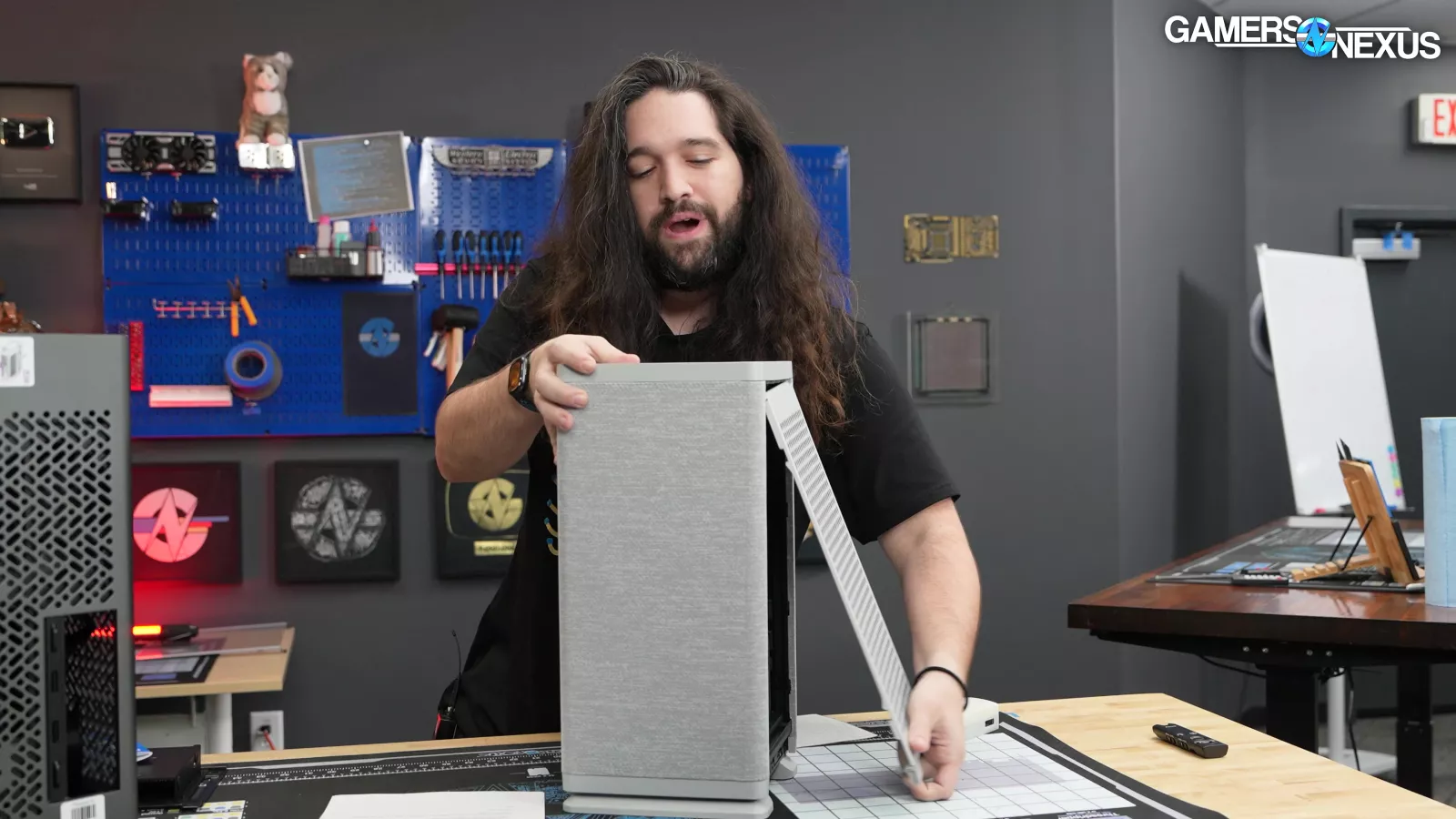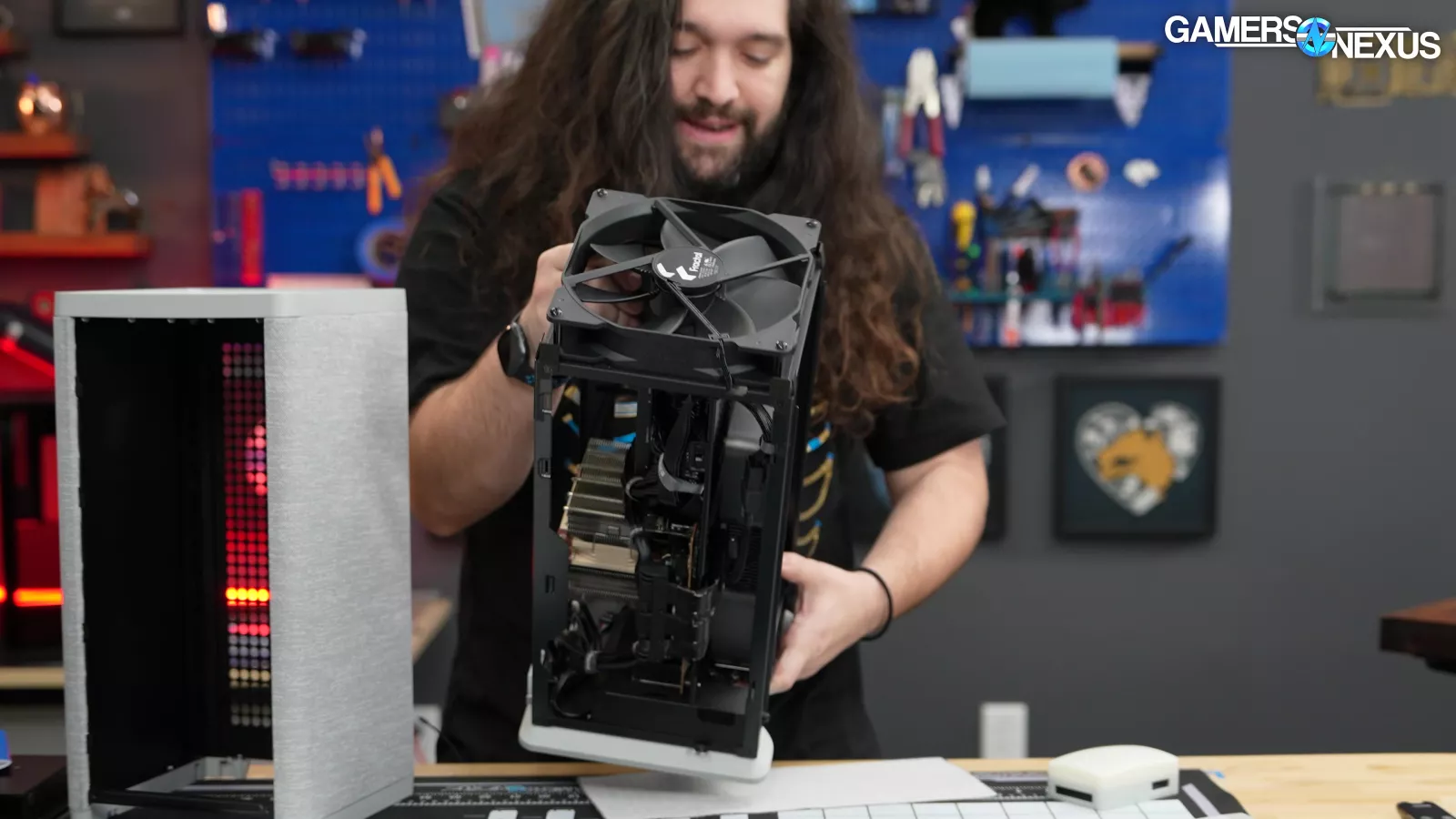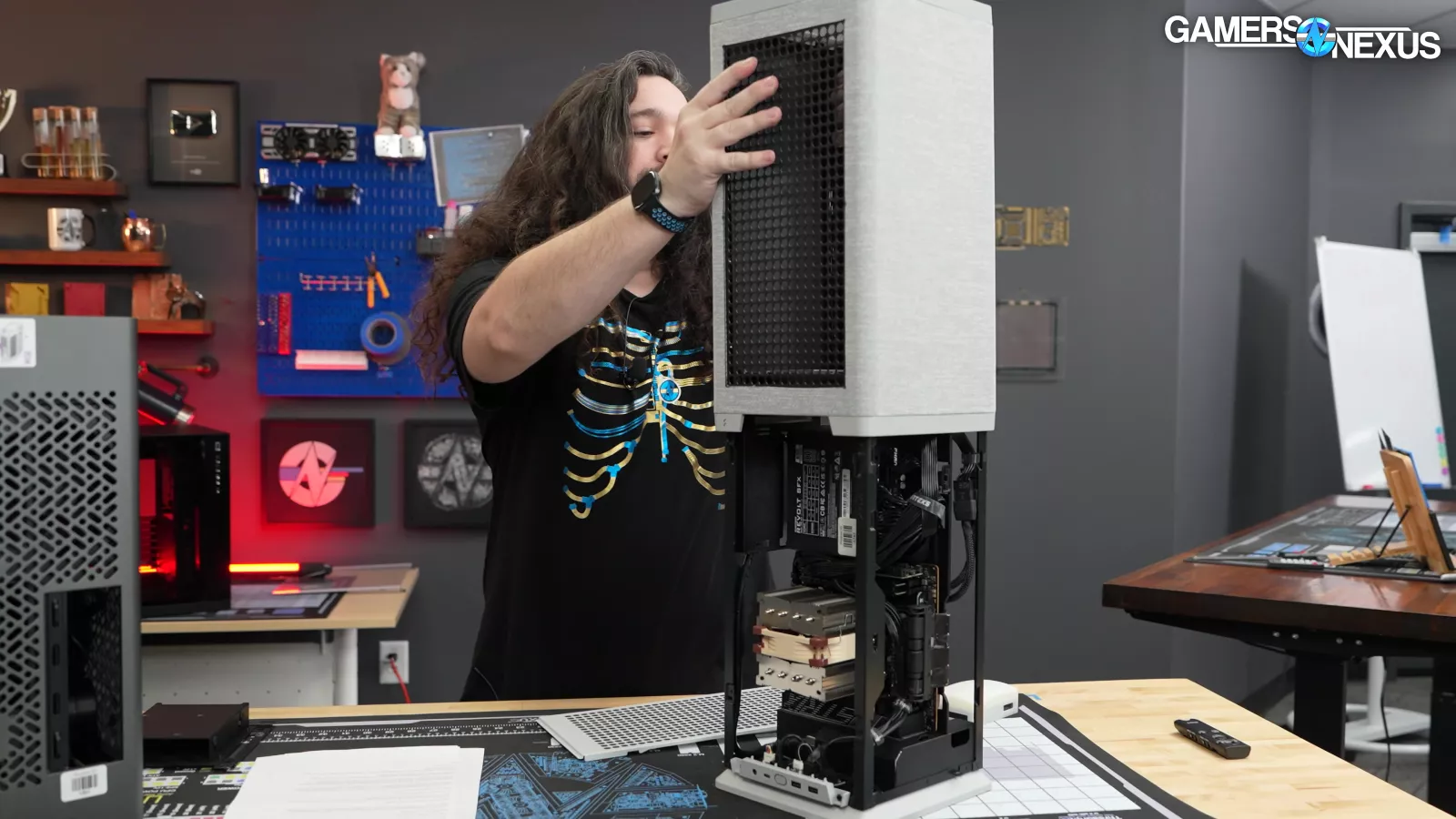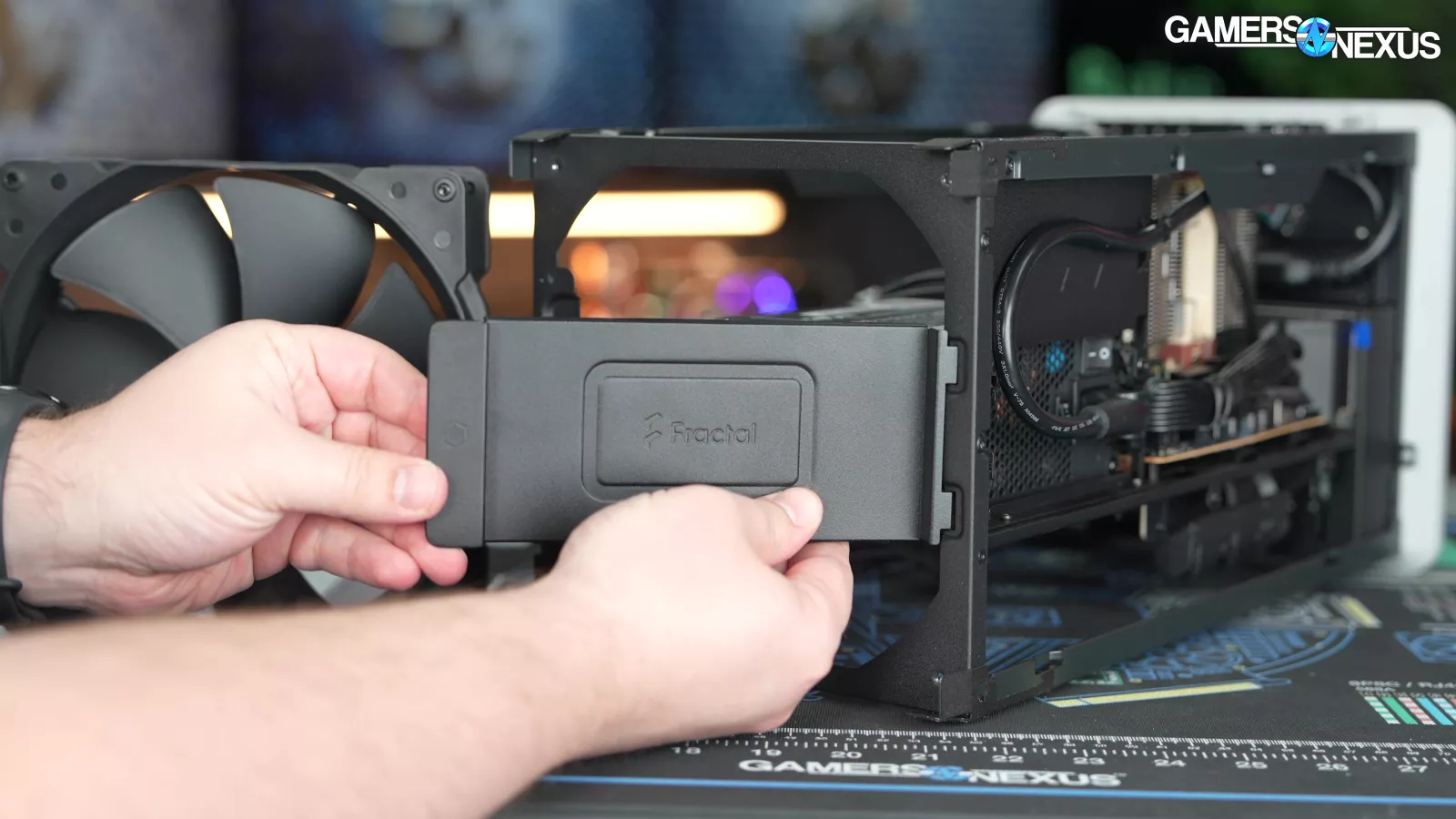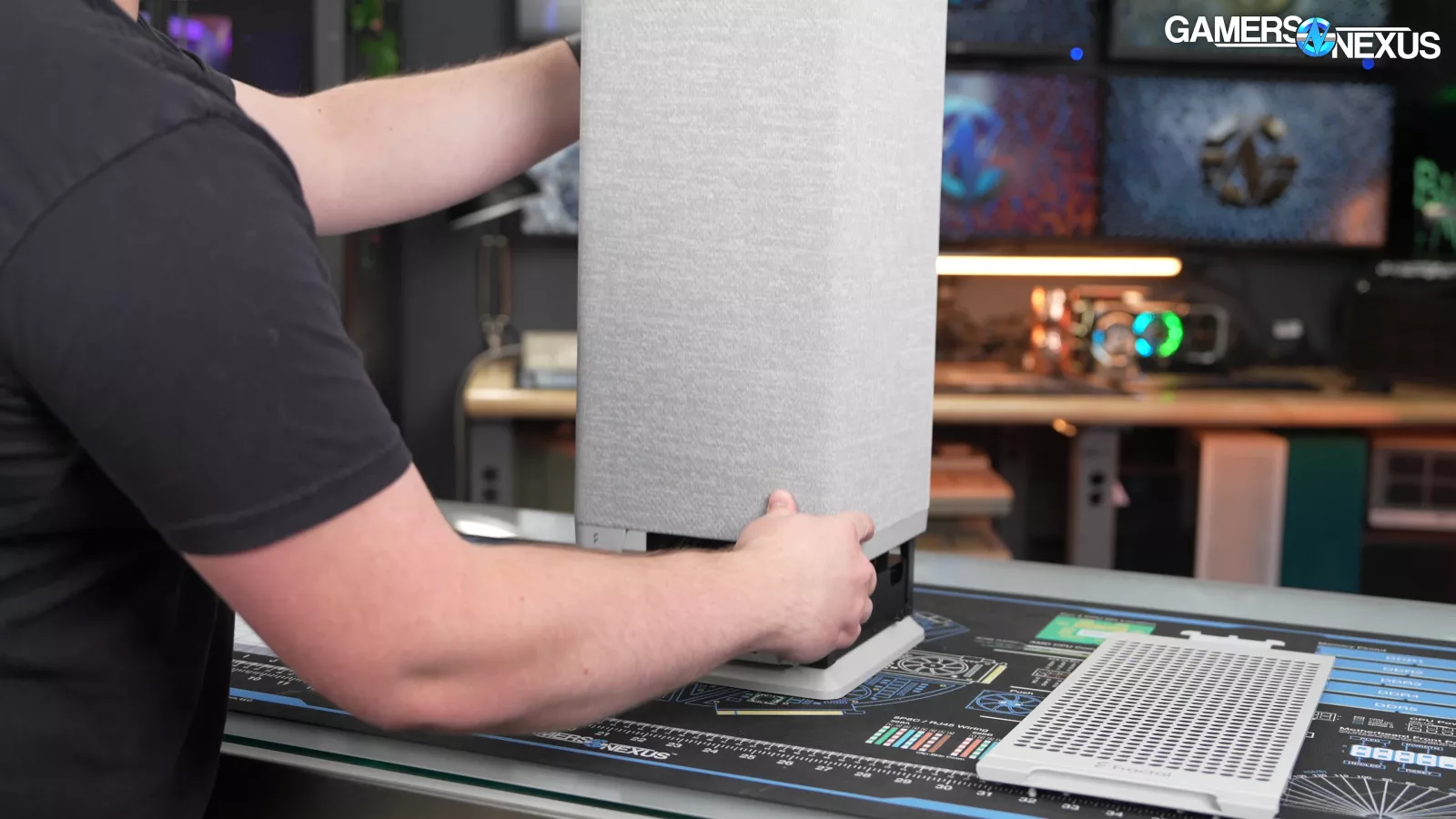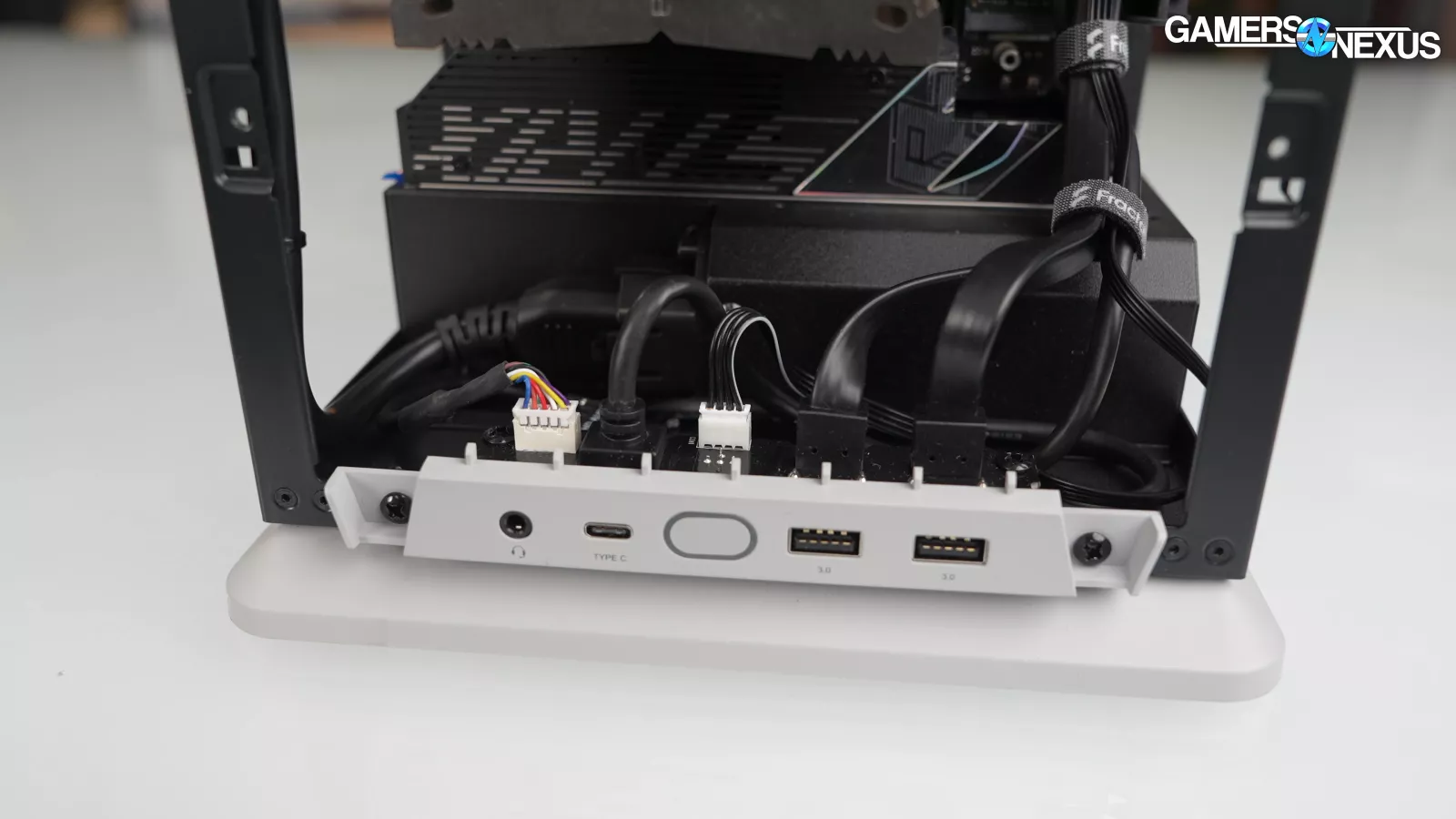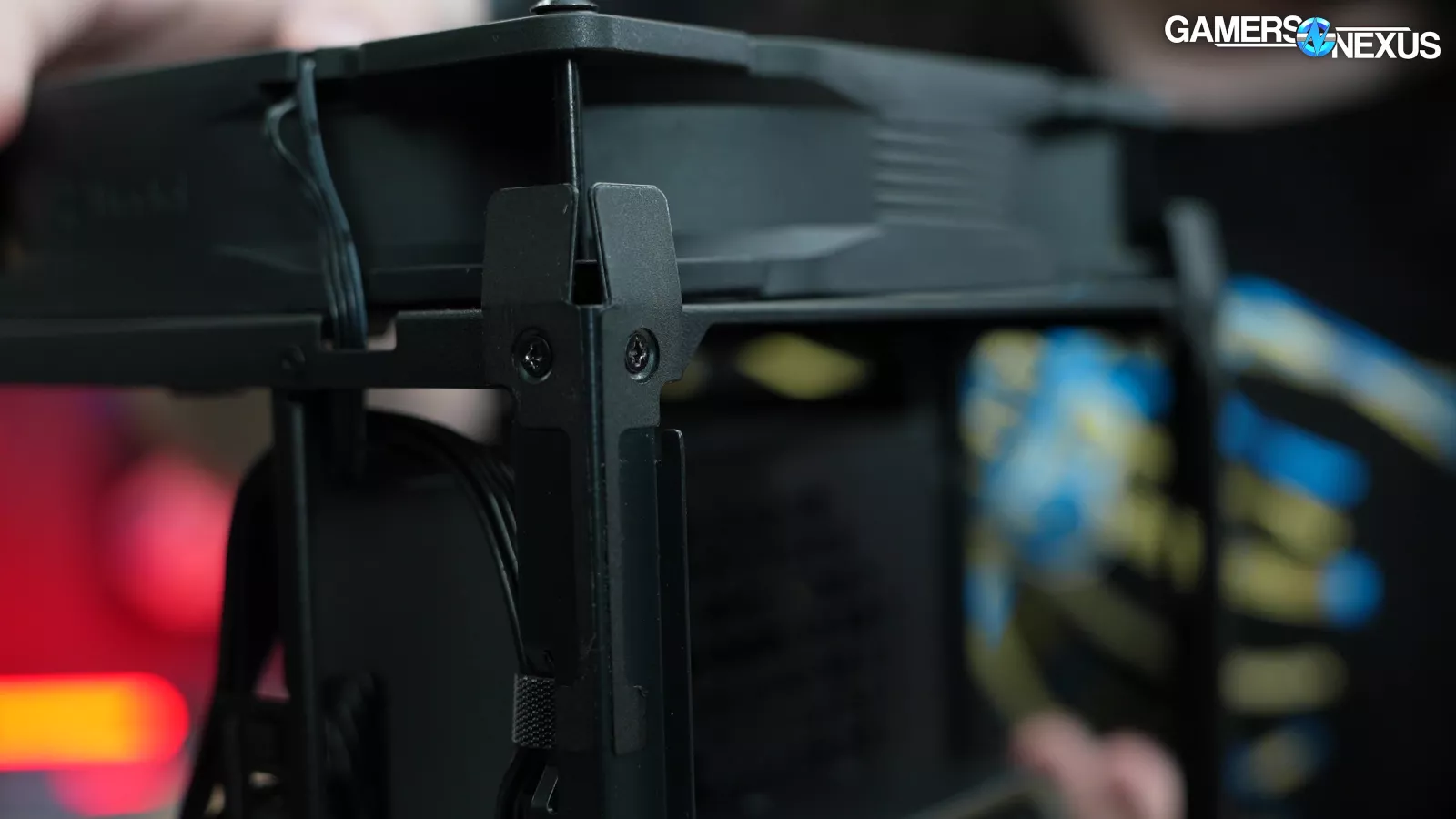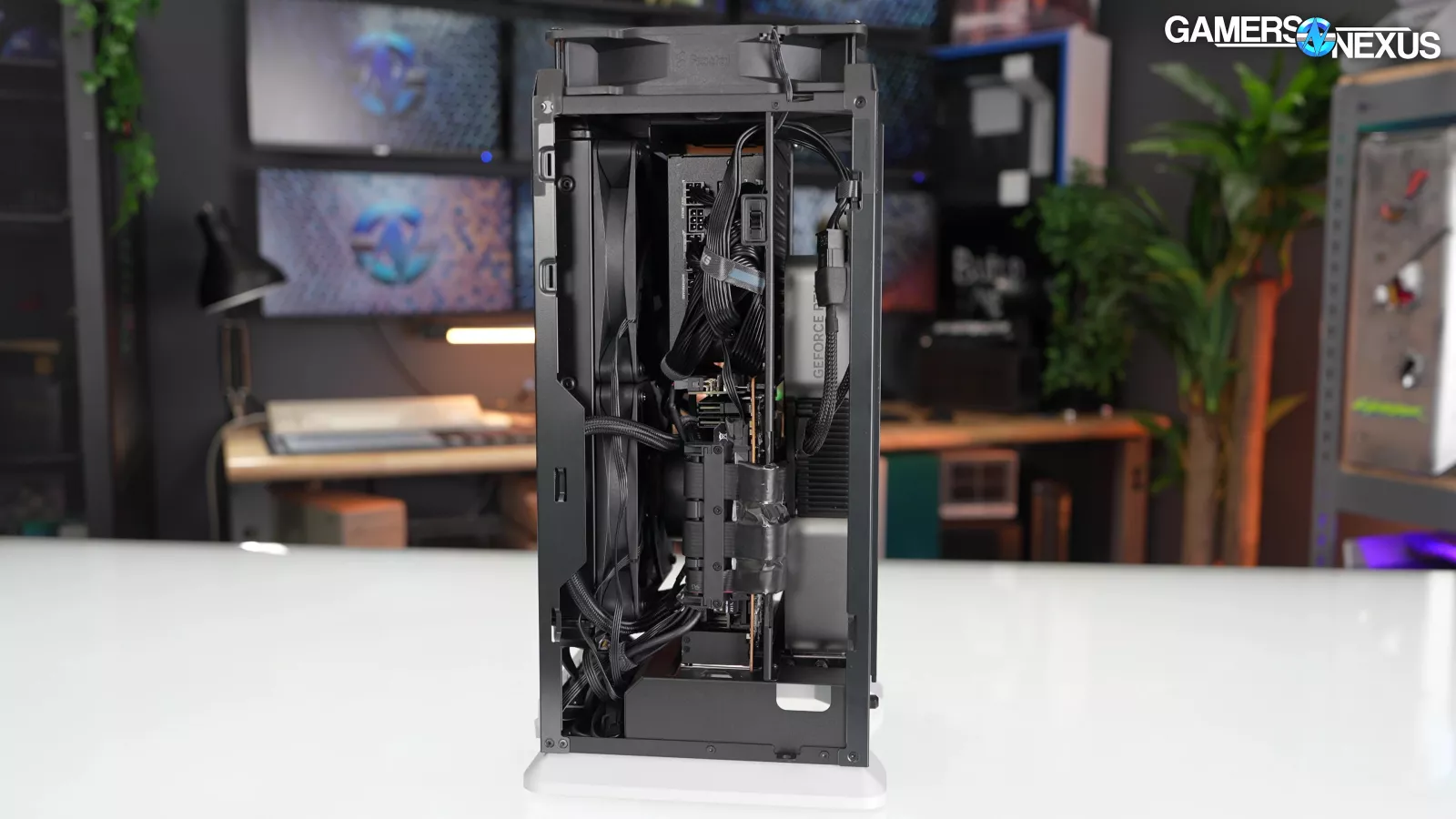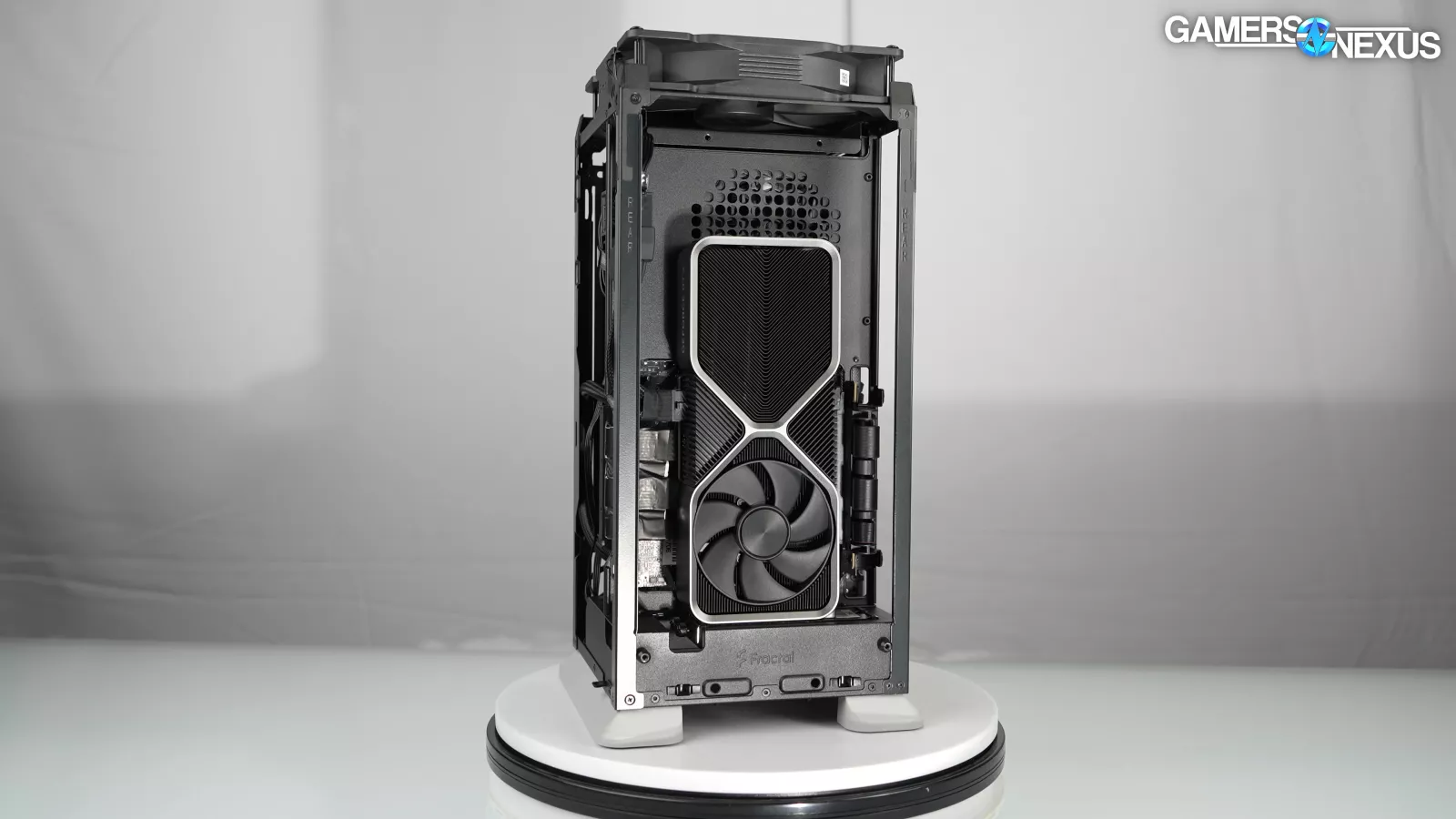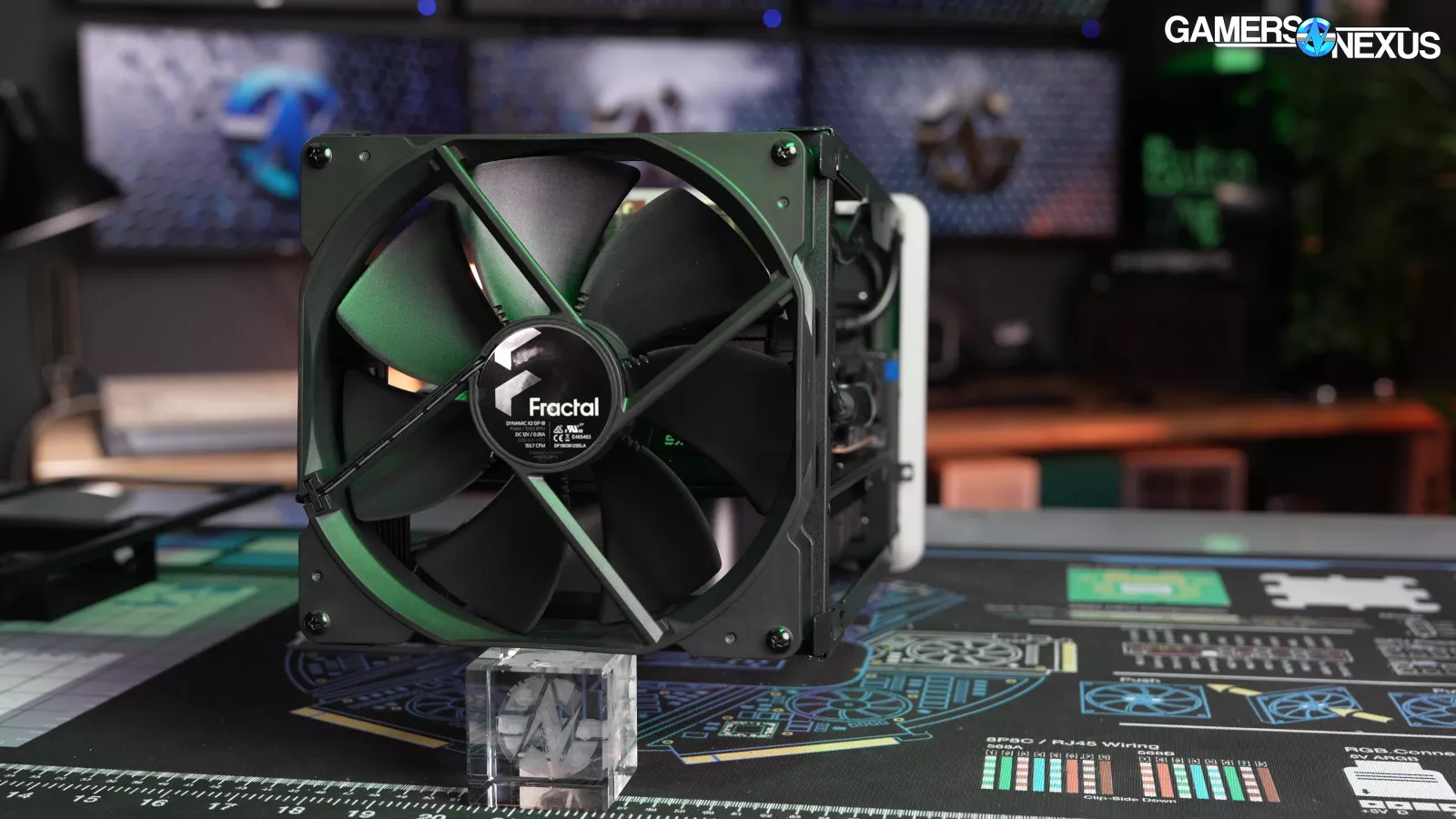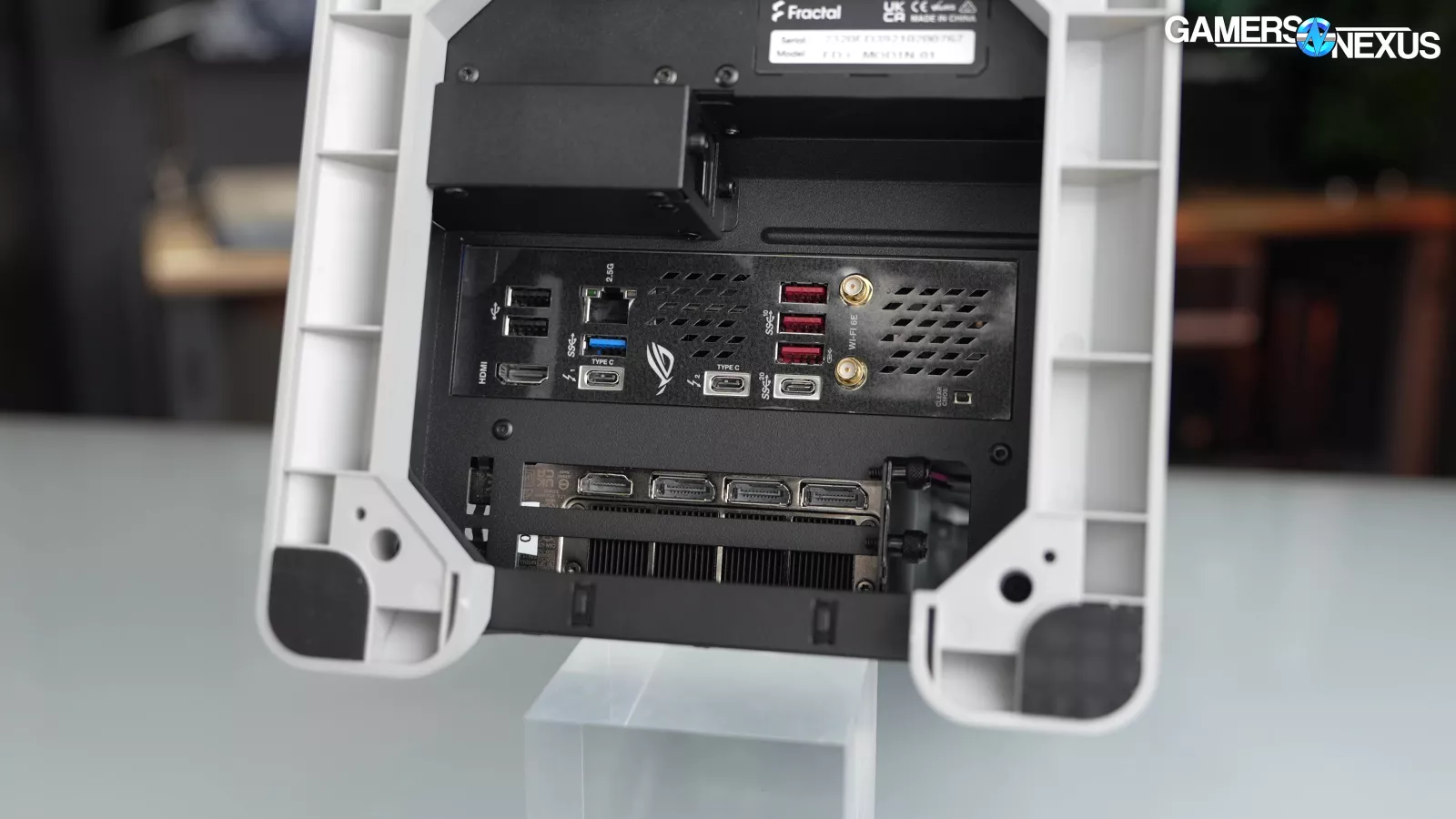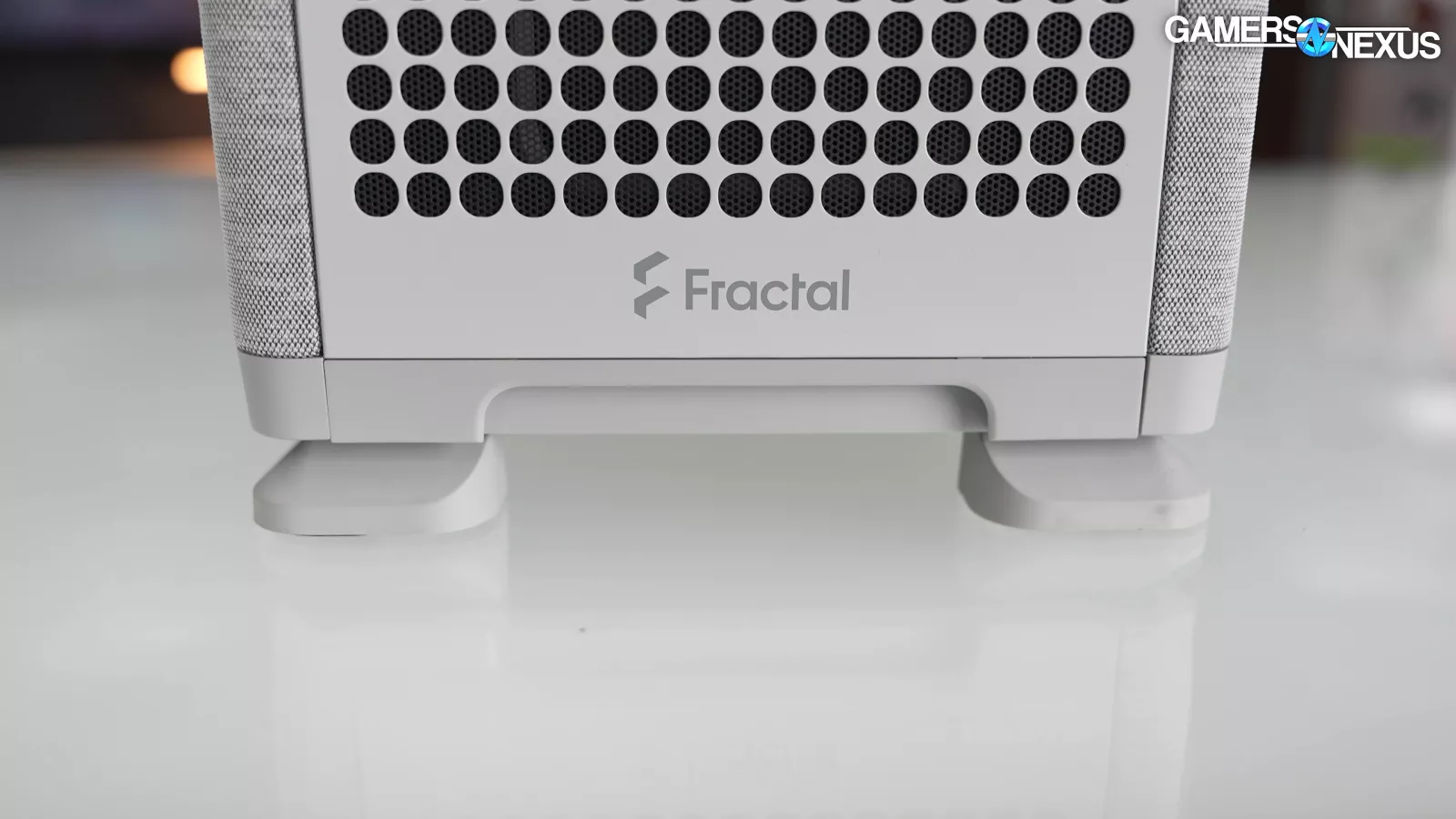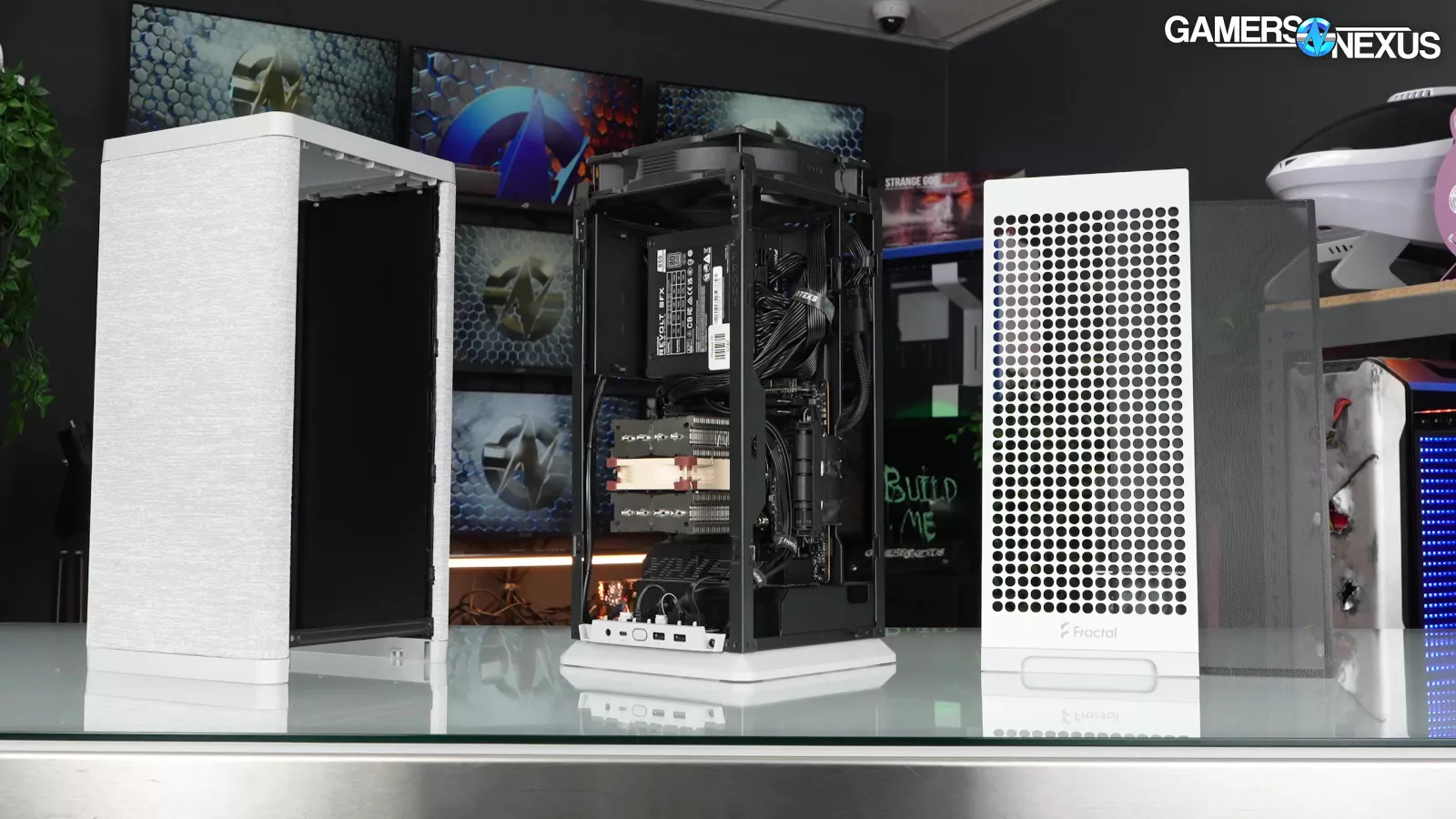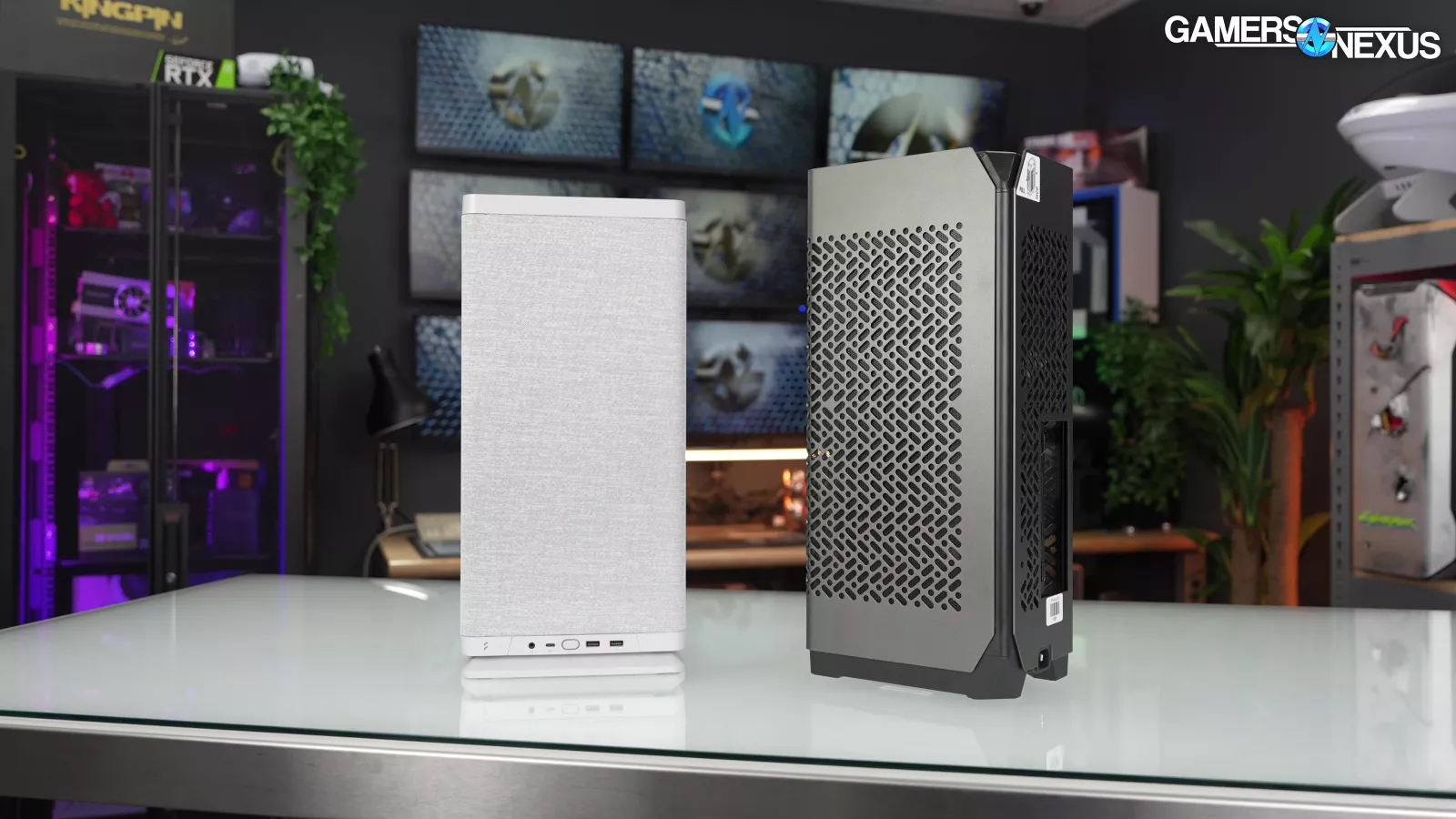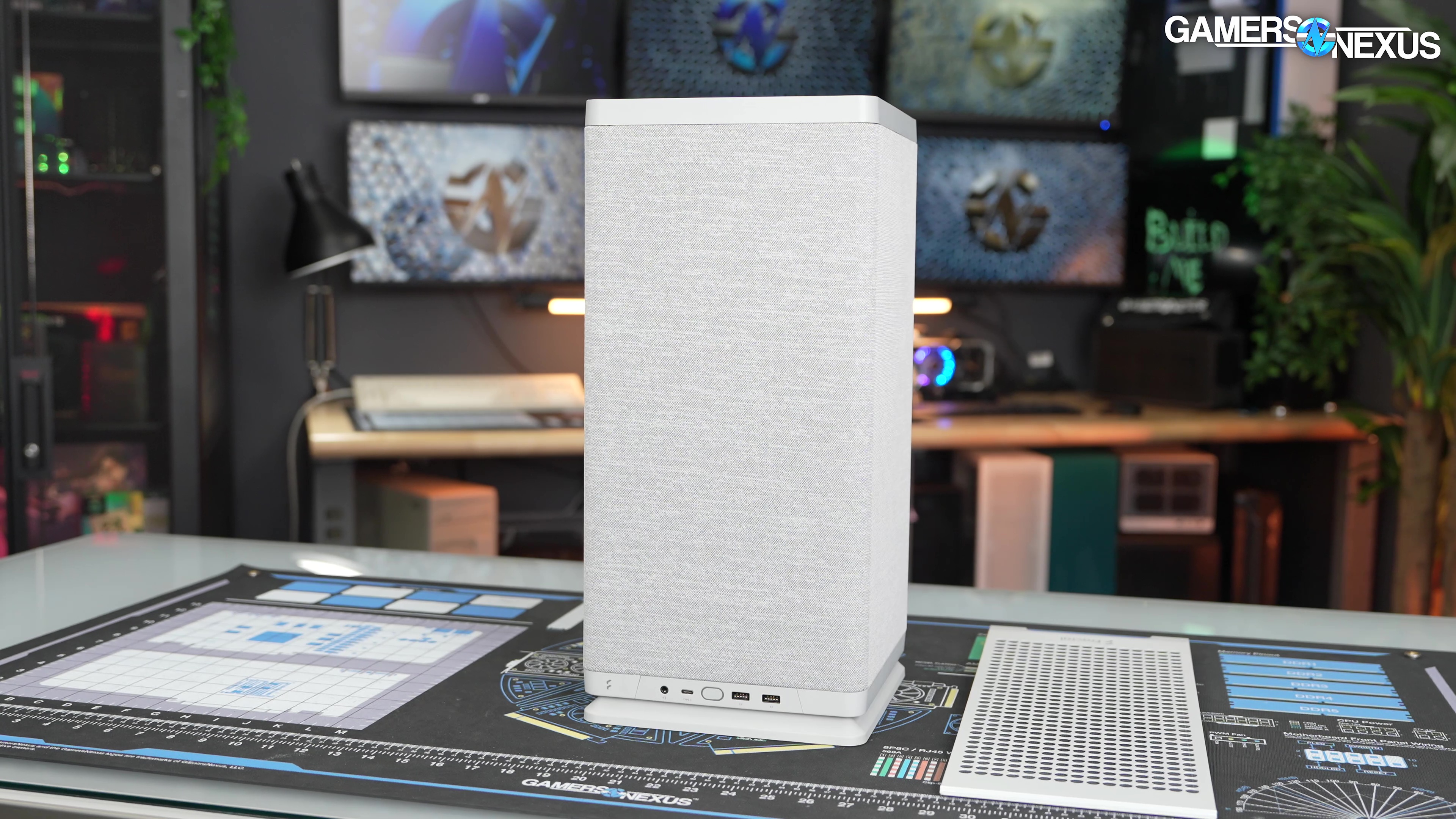
We cut off a section of the Fractal Mood’s fabric to analyze how its exterior impacts air flow
The Highlights
- The Fractal Mood uses a fabric exterior and looks like a cross between an air filter and a Google Home speaker
- The Fractal Mood has air flow issues in terms of fabric porosity and case-design
- The Fractal Mood prioritizes form over function
- Original MSRP: $150
- Release Date: June 28, 2024
Table of Contents
- AutoTOC

Intro
The brand new Fractal Mood Mini-ITX case is wrapped in airflow-impeding fabric that stifles performance and makes it look more like an air purifier than a computer. It can also sound like one.
One of the noises it makes is an oscillating tone that’s only present when the shell of the case is on, and goes away with it off.
Editor's note: This was originally published on July 9, 2024 as a video. This content has been adapted to written format for this article and is unchanged from the original publication.
Credits
Test Lead, Host, Writing
Steve Burke
Testing, Writing
Jeremy Clayton
Video Editing
Vitalii Makhnovets
Camera
Tim Phetdara
Andrew Coleman
Writing, Web Editing
Jimmy Thang
One of the better aspects of the case is the mechanical design -- sometimes. The back panel pops off and the entire exterior shell lifts off in one piece, revealing a huge 180mm exhaust fan that takes up the entire top of the case. It’s priced at $150, which is middle of the road in the ITX world.
So, the Mood has some really interesting acoustical characteristics, along with unique materials choice and construction. When we first saw it, we also thought that -- if executed well -- the design could be good for thermals, but it all depends on the execution of the concept.
The Mood’s pitfalls include potentially guillotine-ing the cables with the exterior of the chassis if it drops down too fast and there are dangling cables protruding out of the case, and its top-mounted SSD bracket can impact GPU thermals in a big way. A bad way.
We were ultimately let down by the Fractal Mood: While it has a unique aesthetic, the case falls short in many areas.
Let’s get into it.
Fractal Mood Main Features
The entire exterior shell can be removed in two pieces. It’s toolless, which we like for ease-of-use, and there are two screws on the rear to lock the shell in place for transport. Small attention to detail like mylar tape helps prevent unpleasant scraping on shell removal. This is one of the best things about the case – there’s pretty much unobstructed access to the parts inside with the shell removed.
The parts are arranged in an upright/tower sandwich layout with the motherboard and PSU on the front side of its stationary spine. The GPU is on the back side, connected to the motherboard by an included PCIe riser. The entire top of the case is taken up by one of Fractal’s 180mm Dynamic fans to pull out warm air from both the CPU and GPU sides of the case. This creates a negative pressure system where air is pulled in through the side panels.
The Mood continues Fractal’s experimentation with alternative materials outside the norm of what is typically found on computer cases. The Fractal North and Terra both incorporated wood into the cases in successful ways that ultimately ignited an industry trend that has taken off in its wake.
Now Fractal’s trying out fabric. Its Ridge case in 2022 started this with a small panel of fabric on the front, following the InWin Alice previously. The Mood has fabric wrapped around nearly the entire outside of its exterior shell, which creates a unique look for a PC case and is reminiscent of Google’s Home speakers. It’s well applied and it's not loose. Even directly beside where we cut the panel, it’s still firmly in place with some kind of adhesive.
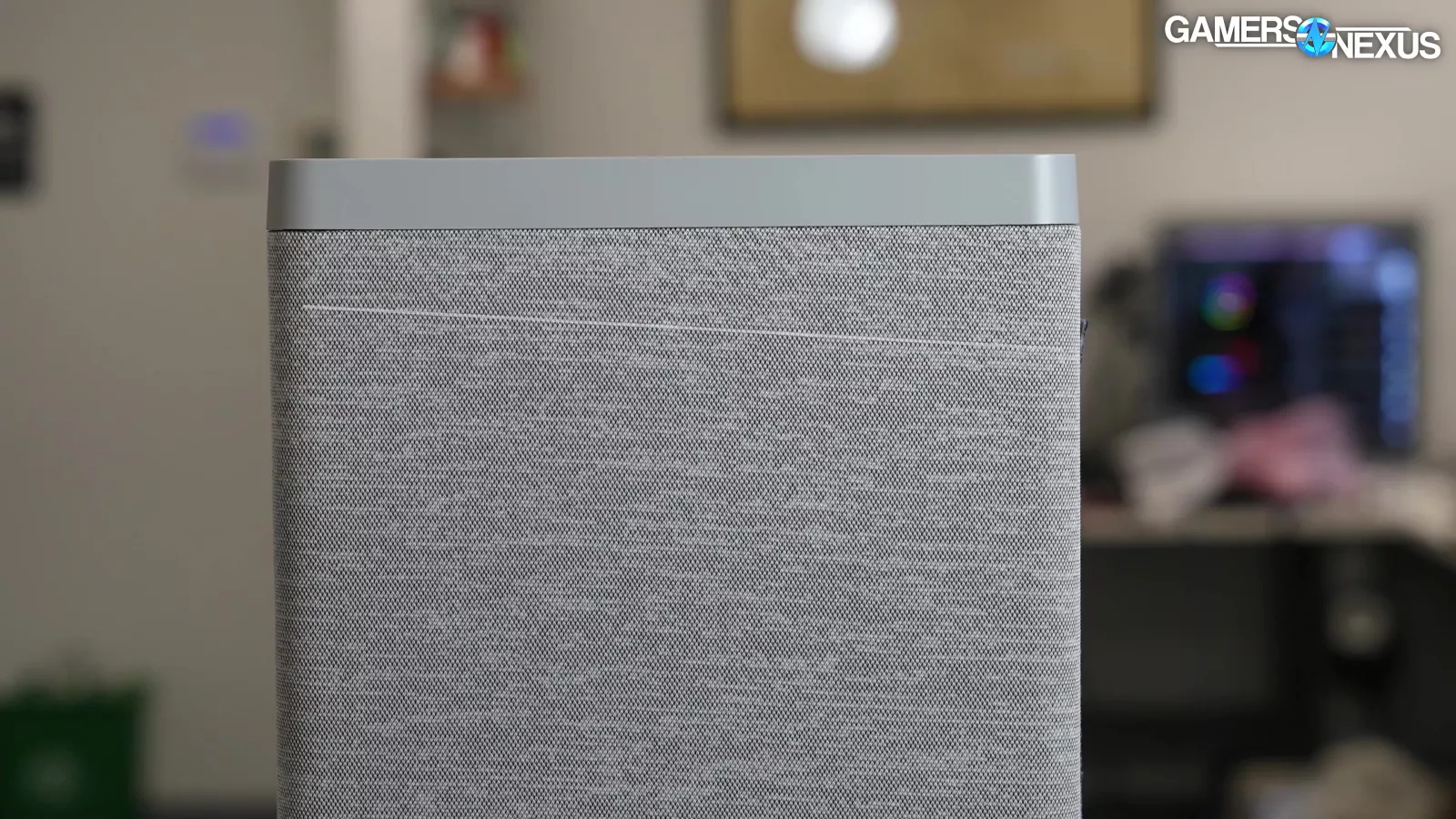
The weave of the external decorative layer on our sample was misaligned across the front, which could be disappointing to users who want the super clean and symmetrical look.

Underneath the exterior layer is a structural weave, and underneath that is a layer of perforated plastic with holes that align with the holes in the panel. This plastic also seems to act as the adhesive holding the fabric in place. Only the front and rear of the case has ventilation for intake – the sides are totally solid, which is intentional.
At first glance it seemed restrictive to airflow -- and that’s because it is. You’ll see that in our thermal tests.
We can’t objectively comment on aesthetics for obvious reasons. You can make-up your mind on the look. Subjectively, we think Fractal is almost getting to the point of over-pandering to its “grown-up gamer” audience. That doesn’t factor into our critiques of the review, though, as it’s ultimately subjective and up to you. There’s enough to criticize without worrying about the look. The Mood is just the other end of the style scale opposed to things like the Cougar Conquer series.
In both the wood and fabric instances of alternative case materials, it was InWin that did it first, but Fractal that made it successful. InWin had wood-accented versions of the 305 and 806 that it showed off in 2017, but as far as we know, they never came out. Then it had the Alice in 2019 with a full fabric cover, which did launch but was of limited success due to its hamper-like appearance and limited marketing resources.
Fractal Mood Overview and Competition
The Mood is $150, which is way below its closest competition – the Cooler Master NCORE 100 MAX. The NCORE 100 MAX is currently $350, but comes with a power supply and cooler. The prices could be somewhat comparable once you factor-in those costs.
Other loosely similar cases include the Thermaltake Tower 200 and HYTE Revolt 3 – both of which are cheaper and don’t use PCIe risers.
The build layout leaves all of the main I/O from the motherboard and GPU oriented downwards, so the case has to be tilted over to connect or disconnect anything. This is something the Cooler Master NCORE 100 MAX did better by having the motherboard I/O still face the rear of the case. There’s about 67mm of space underneath and we didn’t run into any issues with cables fitting, but it’s possible that the bulkiest of USB or display cable plugs may not fit.
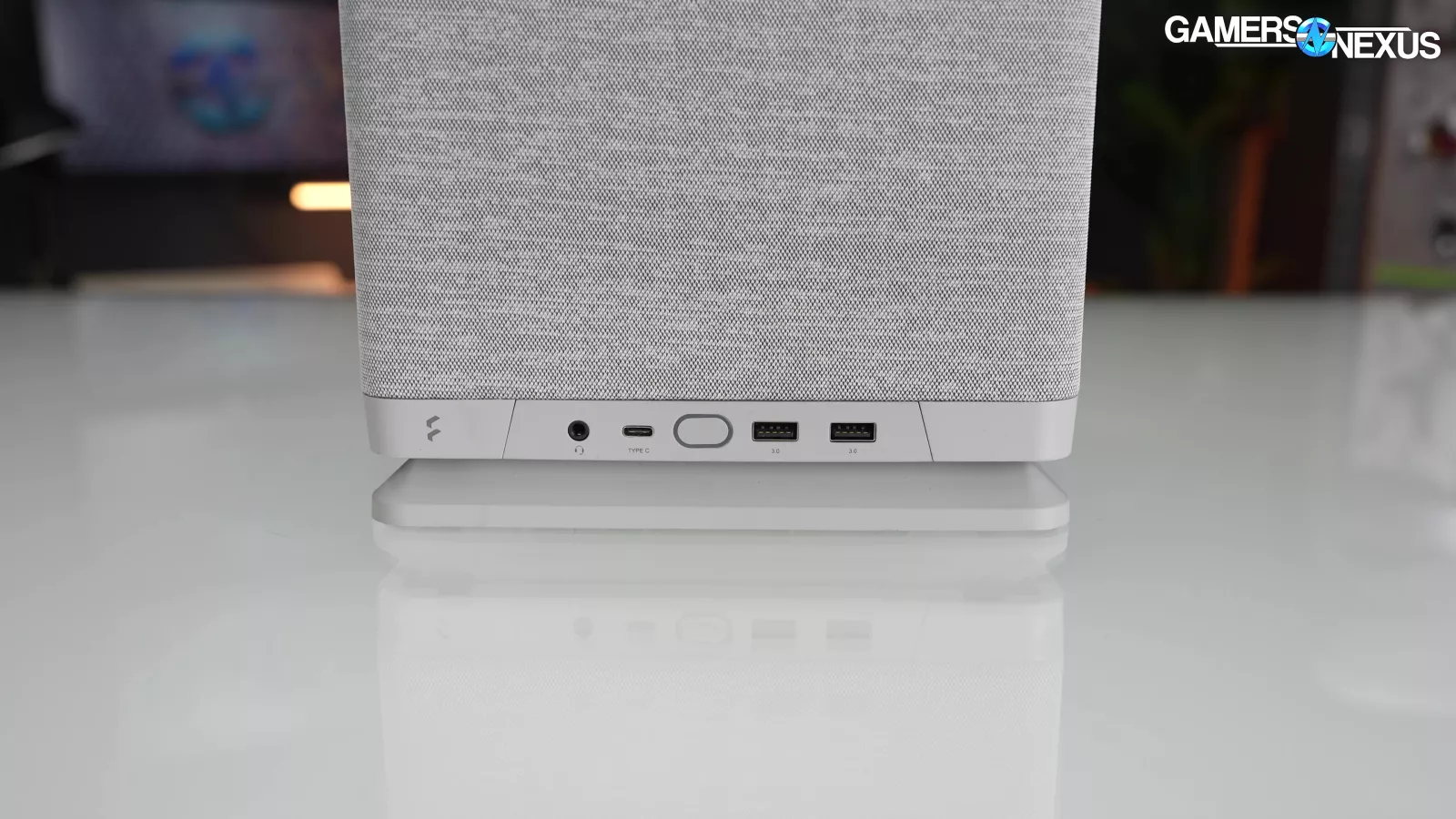
Front I/O is just about as good as you can expect on an ITX case, with two USB type-A ports, one type-C, and a combo audio jack. We typically like to see two jacks that include separate headphone and microphone ones. Since all the standard I/O is on the bottom, we would have liked to see one or two more USB ports – maybe via a built-in hub.
Fractal Mood Dimensions and Fitment
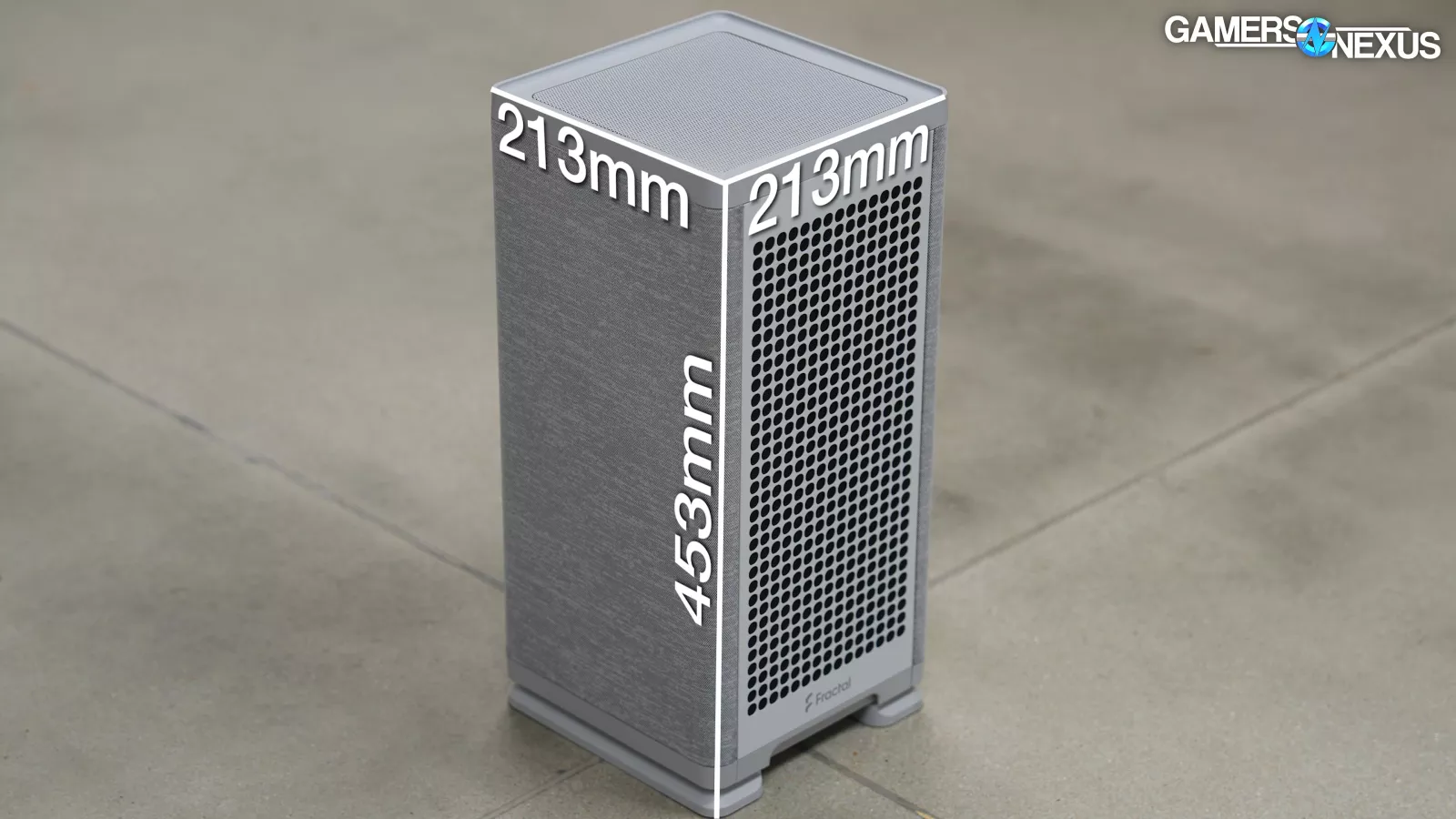
The Mood measures in at 213x213x453mm. Fractal states 212mm for width and depth, but ours is 213mm. We’re glad Fractal is being realistic with its measurements. The volume calculates to 20.55L, which breaks the imagined 20L SFF barrier that some uphold. The Mood is tall, but it doesn’t take up much space on the desk – it’s at least SFF adjacent.

Fractal isn’t clear on what the maximum CPU air cooler height is – it’s either 114mm as shown on its webpage, or up to 120mm as shown in the manual, or 110mm as we were told in-person. Based on our measurements, it seems like 114mm is more accurate. For air-cooled tests, we used the 110mm tall Noctua NH-D9L, and there’s just a little bit of room to spare with that. If a short enough air cooler is used, a fan could be installed over the top of it using the radiator bracket. It could be an interesting solution for downdraft coolers and would hit the VRM pretty well.
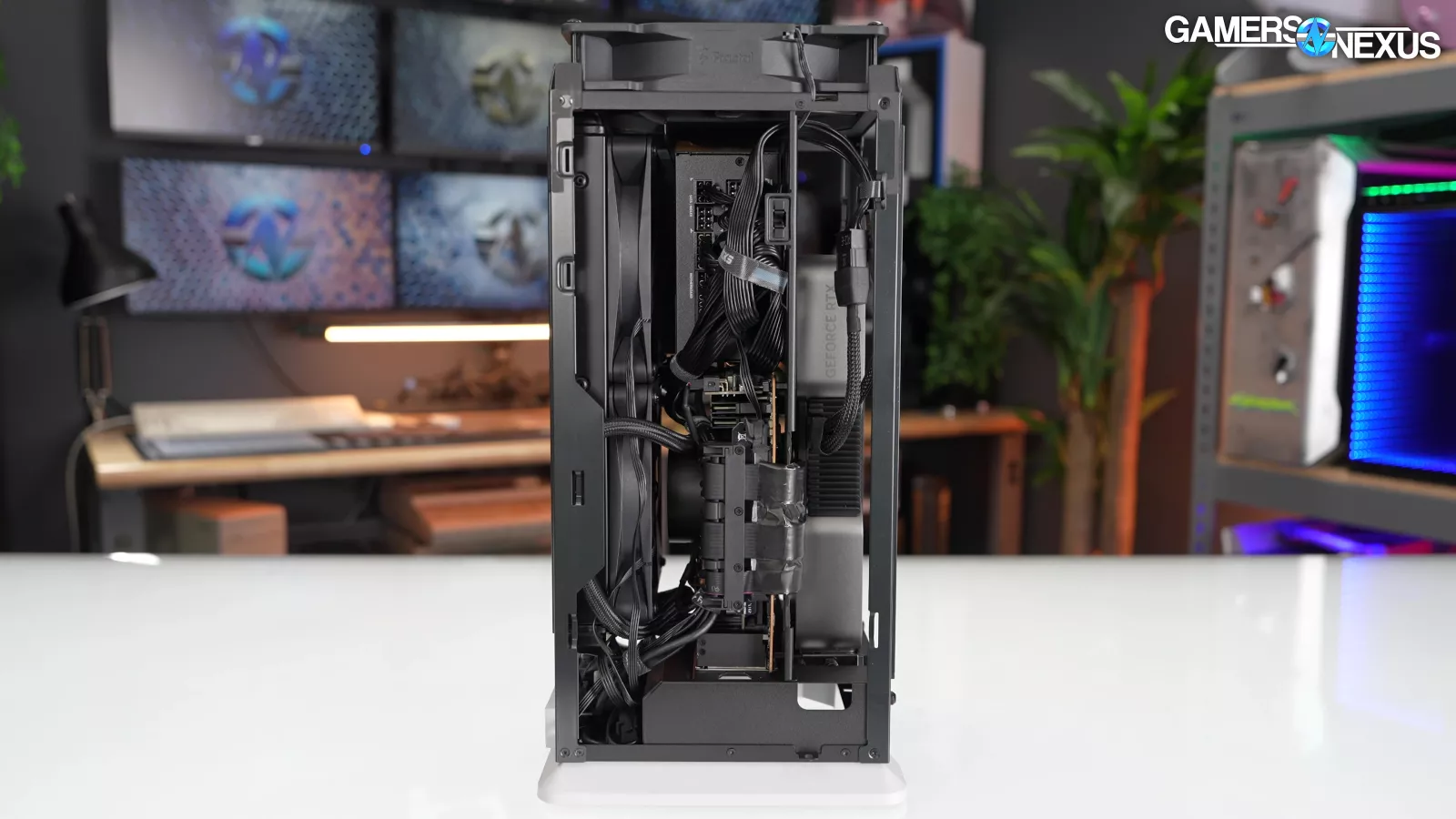
280mm and 240mm liquid coolers are also supported, with a maximum radiator plus fan thickness of 67mm, and up to a 60mm tall block. The thicker the cooler gets, the less room there is for air to actually get out, and cable management gets more difficult. There wasn’t much space left with our Kraken 280, which cuts down on the efficacy of the top exhaust fan and caused some issues for the GPU that we’ll get to in the thermals section.
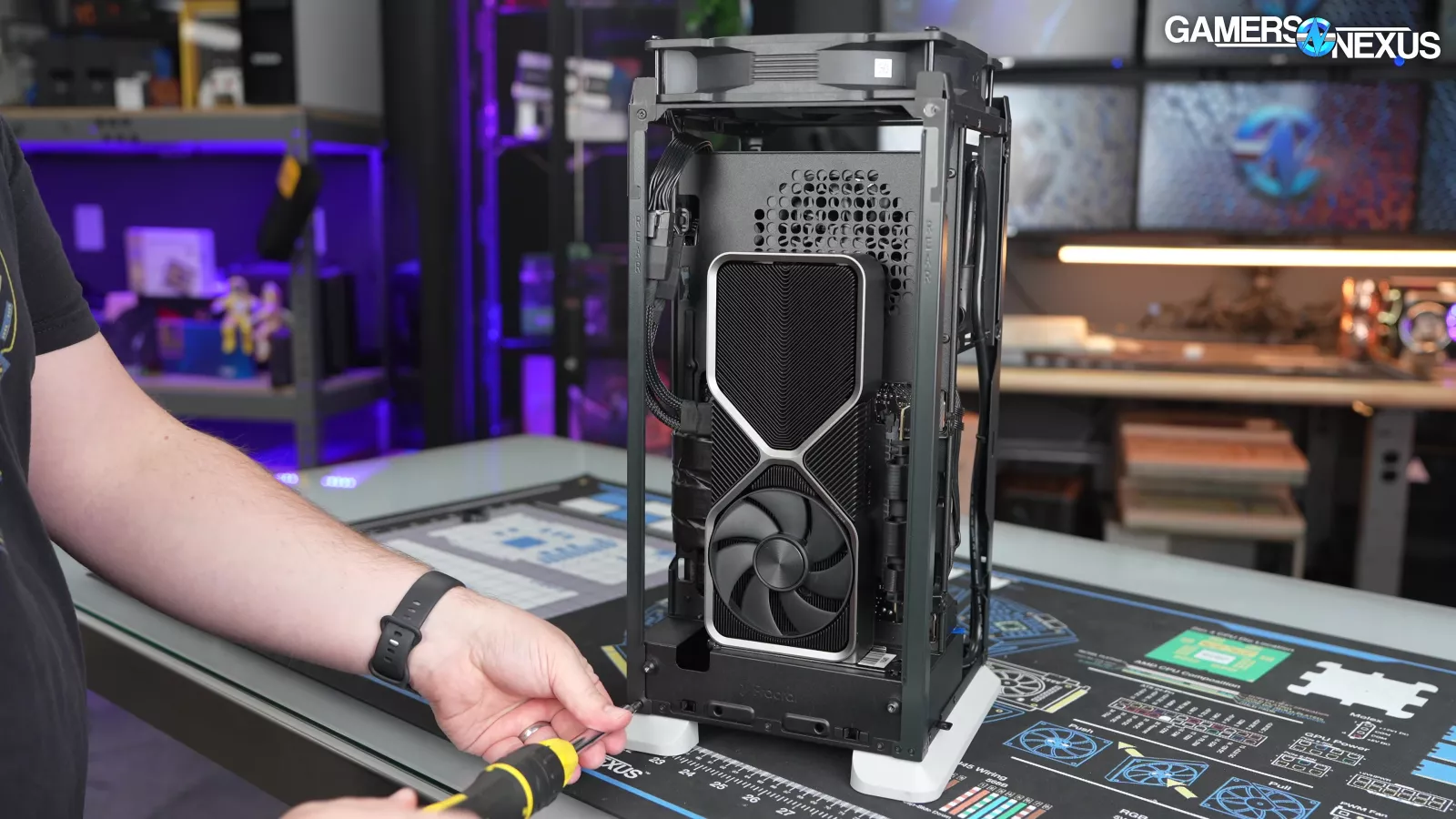
GPUs can be a maximum of 158mm tall (excluding the cable), 325mm long, and 56mm thick (including the backplate). That pretty much keeps the build limited to 2 and 2.5-slot GPUs – roughly around the 4070 Super level. It’s unfortunate that a case of this physical size is so limiting like this in the GPU department.
The case pillar nearest to the top of the GPU is actually removable, giving easier access for installation and removal. It’s a helpful touch.
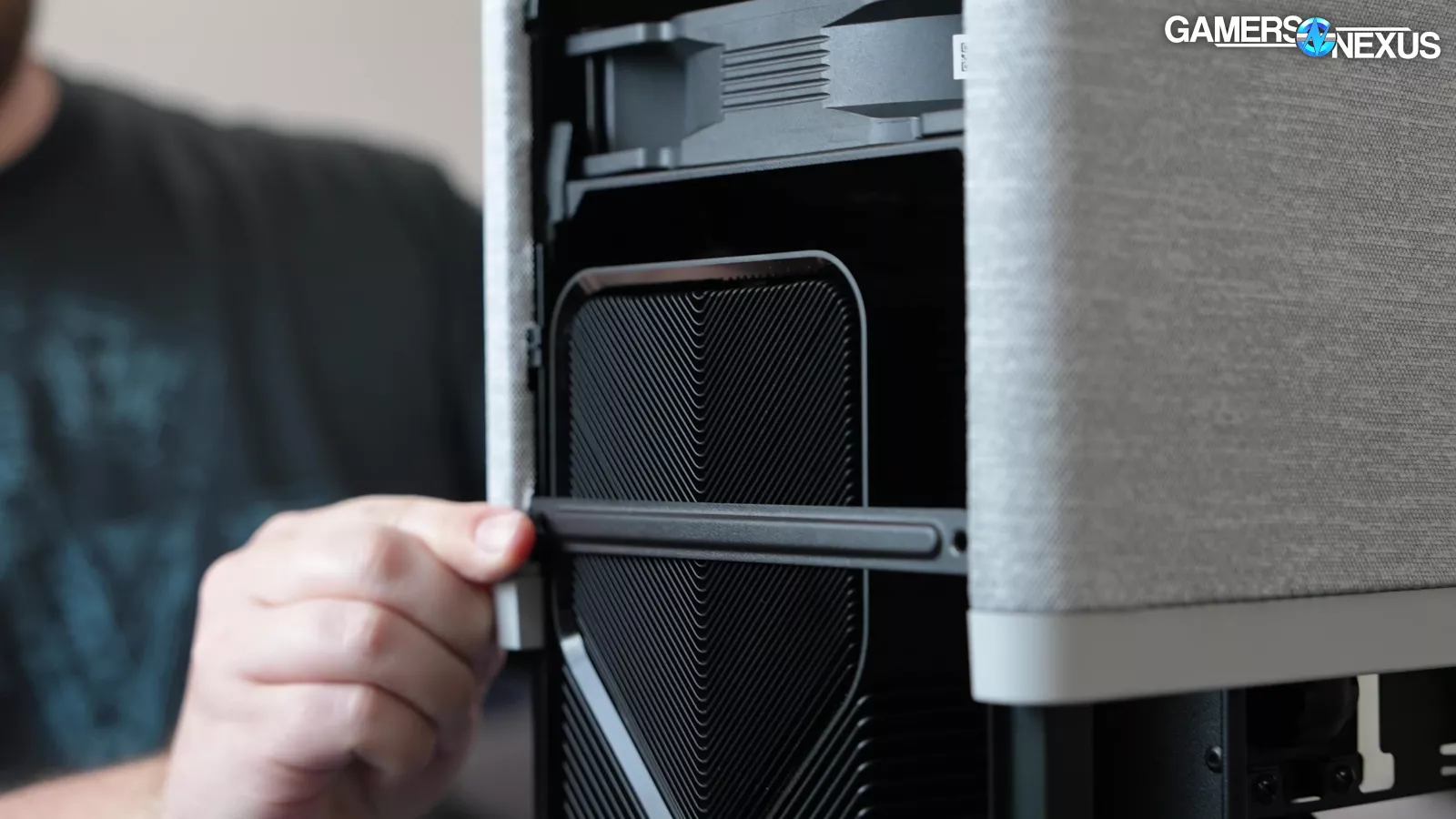
A 3-slot Founders Edition card shouldn’t fit based on Fractal’s measurements, but it actually can with minimal effort. However, there are only two expansion slots in the bottom of the case, restricting the slot-side exhaust.
Fractal Mood Drive Mounts
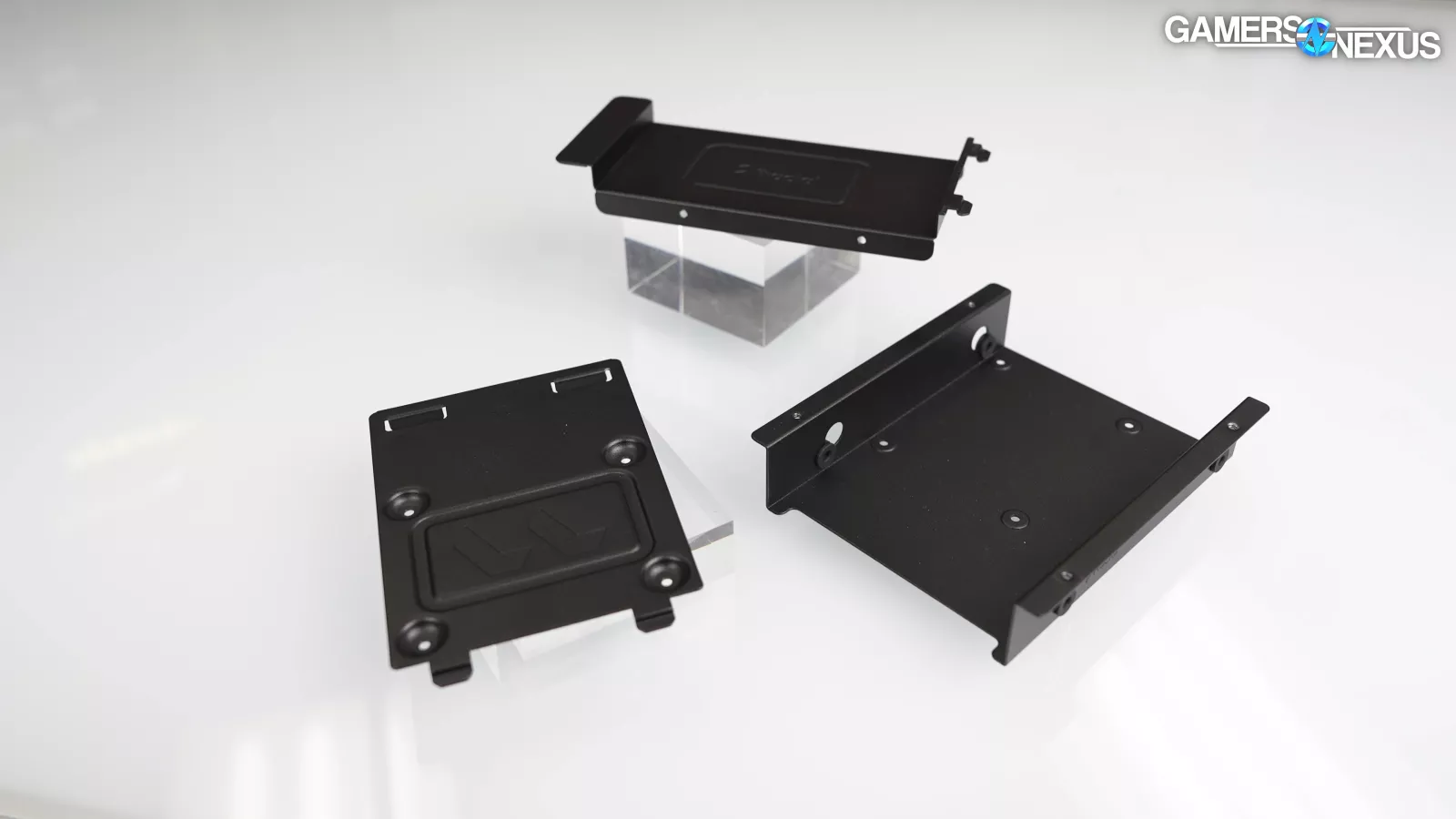
The Mood comes with a couple of drive mounts – one for 3.5” drives that attaches to the upper front fan bracket position, and two for 2.5” drives. One of them attaches to the side near the PSU cables and is totally fine – even beneficial to help with cable management in that area.
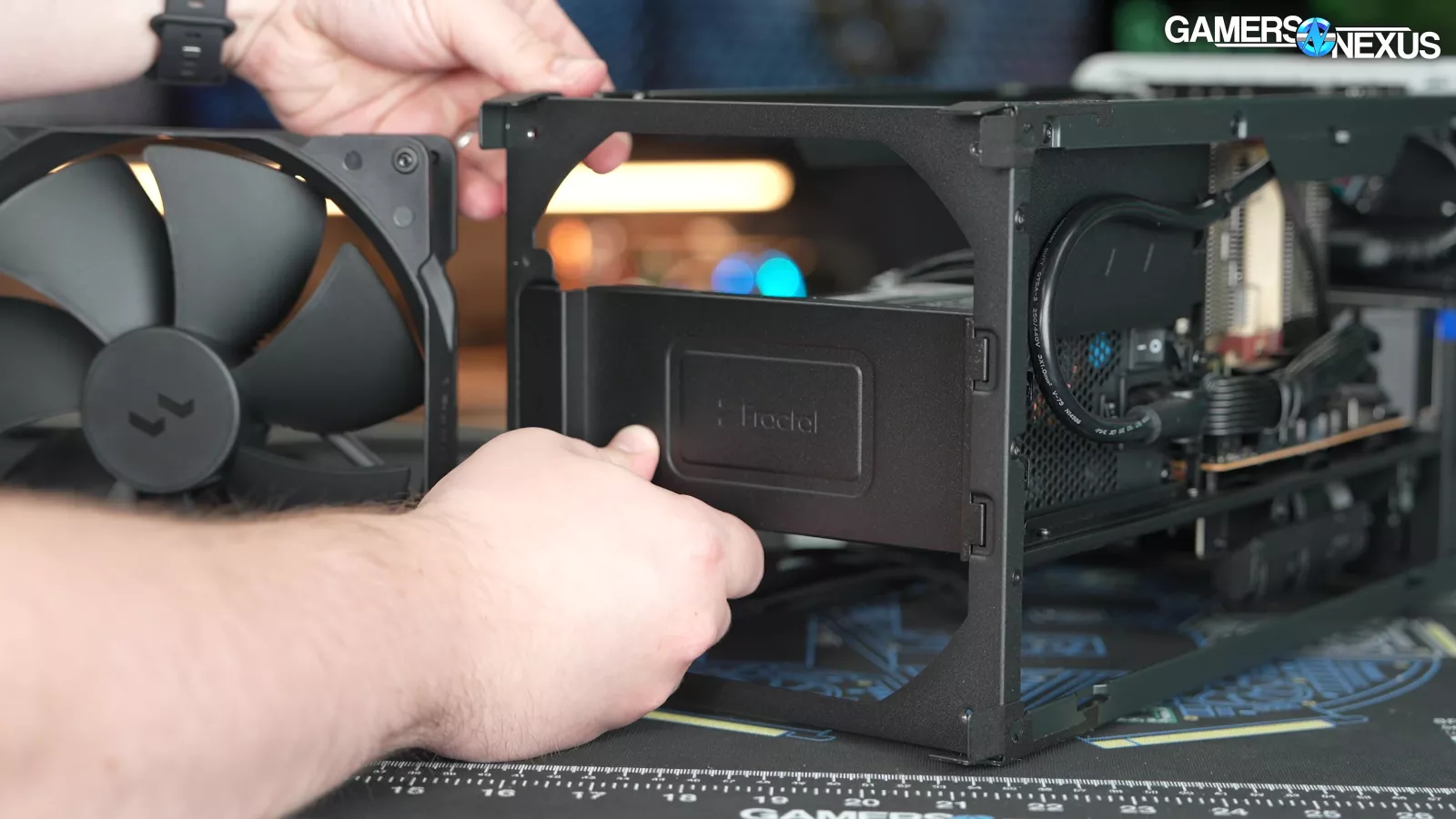
The other is the top mount we previously mentioned. It goes between the PSU and the top exhaust fan, and requires temporary removal of the fan to install. This is a pretty weird spot, and the bracket isn’t ventilated at all, and contributes to blocking off the Mood’s only exhaust. That’s especially true for the PSU exhaust, which ends up significantly blocked. This has a big thermal impact that we’ll get to later.
Mini-ITX Test Bench
| Part | Standard Component(s) | Provided By |
| CPU | Intel i5-13600K @ Fixed clocks & voltages (clocks/voltages determined per case; we may settle on permanent settings once we get past our first few ITX case reviews) | Bought by GN |
| GPU | NVIDIA RTX 4070 FE | NVIDIA (review unit) |
| Motherboard | ASUS ROG Strix Z790-I Gaming WiFi | Bought by GN |
| PSU | Corsair SF1000L 1000W SFX-L Phanteks Revolt SFX 850W | Bought by GN Provided by Phanteks |
| RAM | GSkill Ripjaws S5 2 x 16GB | Bought by GN |
| SSD | Samsung 960 Pro M.2 NVMe SSD | Bought by GN |
| Coolers | VARIABLE Standardized options: 240mm CLC: Fractal Design Lumen S24 v2 RGB 120mm CLC: Arctic Liquid Freezer II 120 "Standard" Tower: Scythe FUMA 3 or Deepcool AK400 Short Single Tower: Noctua NH-U9S Mini-Tower: Noctua NH-D9L Downdraft Low-Profile: Deepcool AN600 67mm Alt. Downdraft: Noctua NH-C14S | Fractal Design, Arctic, Deepcool |
| Additional Fans (Optional) | VARIABLE Standardized options: Arctic P14 Slim PWM PST 140mm Arctic P12 Slim PWM PST 120mm Arctic P8 Max 80mm Noctua NF-A6x25 PWM 60mm Noctua NF-A9x14 PWM 92mm | Arctic Noctua |
Fractal Mood Thermals

Thermals - CPU
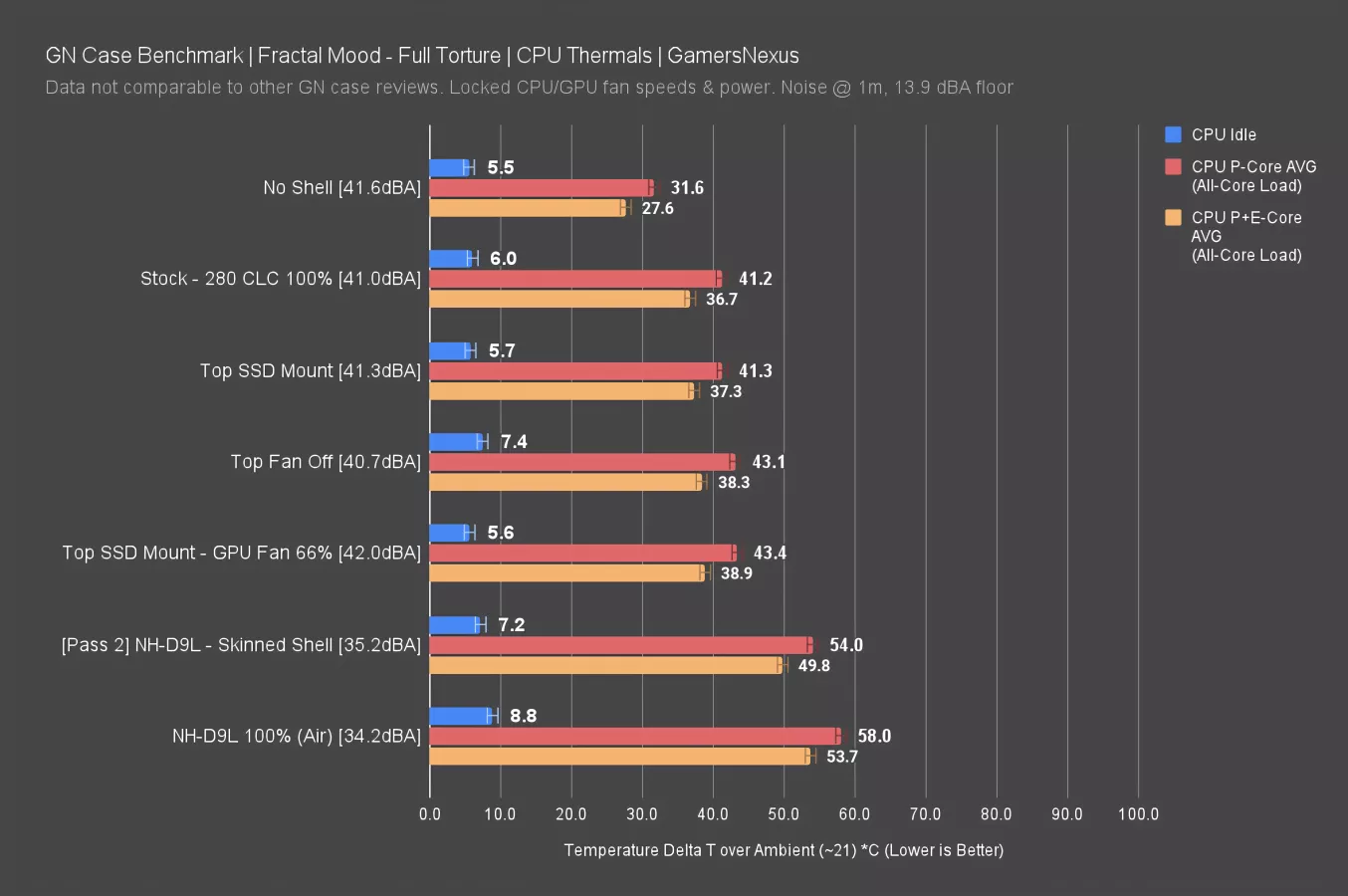
Thermals start with CPU results under a full-system torture workload. CPU frequency and power is locked, as are fan speeds. As usual for our ITX reviews, the data here is not directly comparable to any other case we’ve run in the past.
The stock result with the 280mm CLC at 100% speed came in at 41 degrees Celsius over ambient across the P-cores.
Removing the outer shell resulted in a massive, nearly 10C reduction in the P-core average. This tells us that the outer shell is hugely restrictive for both intake and exhaust. Internally, there just aren’t many places for the air coming out of the CLC’s fans to go. The air gets shoved into a tiny chamber with limited pressure pulling it out, and taller blocks reduce that volume even further. This poor performance is reinforced by the “Top Fan Off” result only causing the P-core average to rise by 2C. The top fan can’t really pull air up through the narrow passage between the internal components and the cooler’s own fans. It’s just not doing much in this chamber.
Switching to air cooling with the NH-D9L at 100% fan speed results in a P-core average of 58 degrees over ambient. The point of this isn’t to compare a tiny tower cooler to a 280mm radiator -- that’s just a cooler review, which we do separately -- but to see what happens when we take away the intake air restriction presented by the fabric cover.
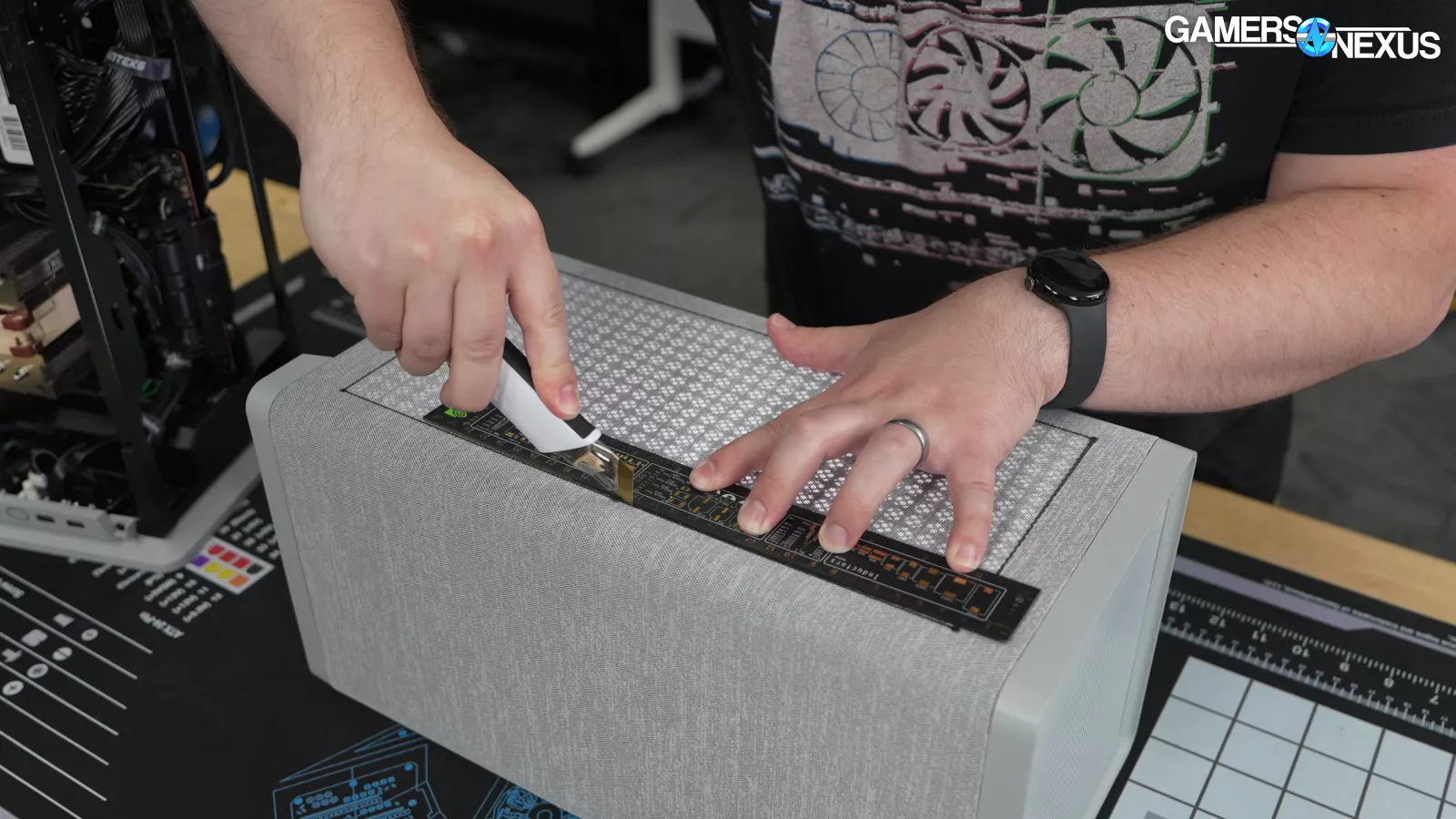
With the front side of the shell skinned, the P-core average dropped by 4C. That’s a lot for just removing the front fabric. This proves that just the fabric is very restrictive on its own. Fractal chose to leave performance on the table in pursuit of a certain look.
The top SSD mount has effectively no impact on CPU thermals, but does for the GPU, so let’s get to that.
Thermals - GPU
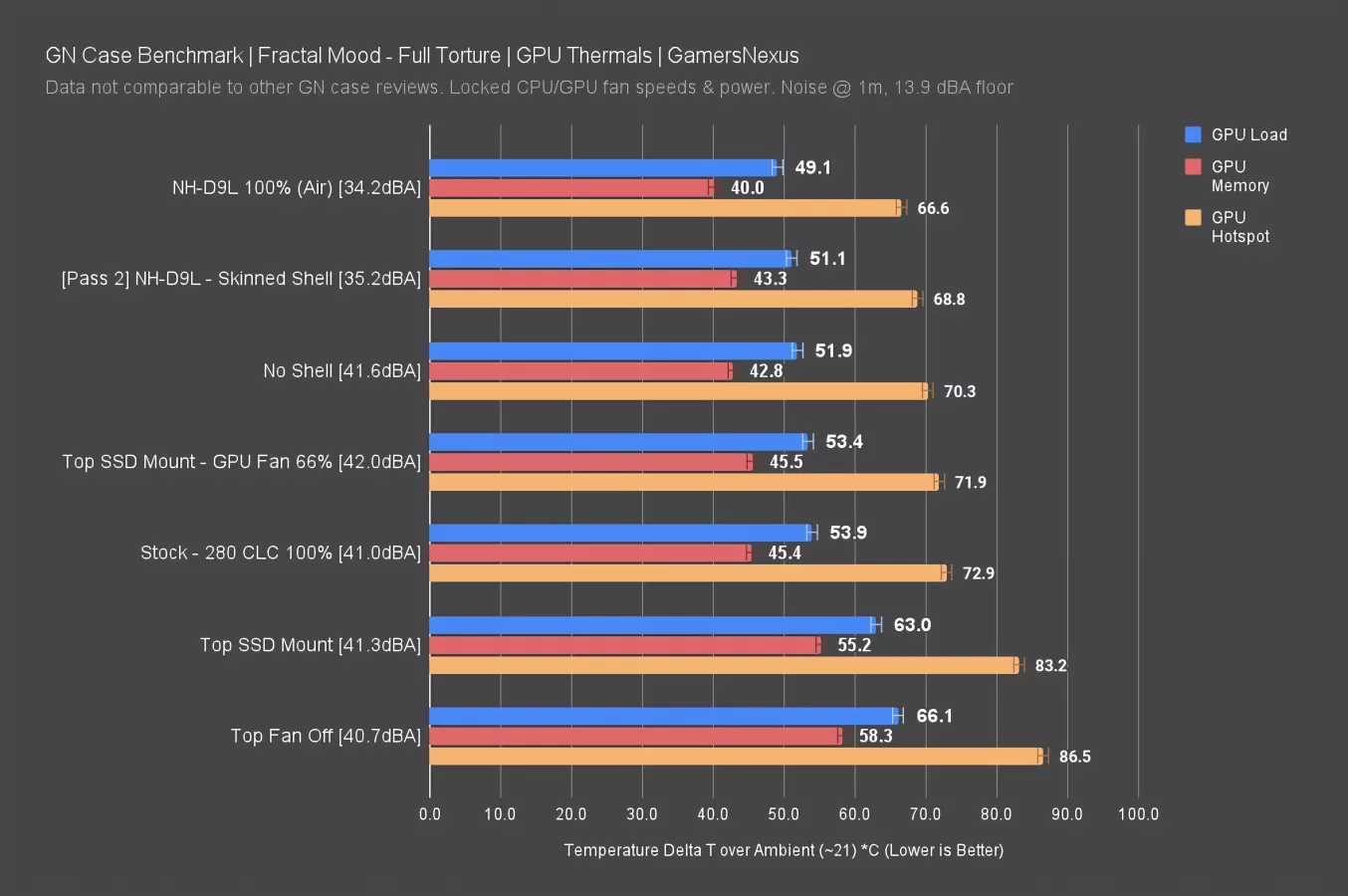
The fans on our 4070 FE are locked at 35% unless otherwise noted.
The air cooler config actually gives the best GPU thermals, with the GPU core at 49C over ambient and memory at 40C. The stock setup with the 280mm CLC is about 5C warmer on the GPU, despite more fans and better CPU cooling. Here’s what’s happening: The exhaust air brought in from the CLC is fighting for anywhere to go, and that includes going into the GPU side of the case. The GPU gets fed this pre-warmed air, maybe even causing a slight re-circulation effect.
Removing the shell drops GPU core temperature by 2C – so not nearly as impactful as it was on the CPU side, which is because the GPU side does not have the restrictive fabric (and the GPU fans are also right up against it).
Adding the top SSD mount underneath the exhaust fan has a huge and negative impact on GPU thermals, raising the core by 9 degrees, which is massive. For a GPU, this increase is phenomenally bad. It forced the GPU clock speed down by almost 150MHz, so without clock throttling, the temperature increase would have been even higher. Fractal’s design here is poorly thought-out and does the GPU a huge disservice.
GPU exhaust from the flow-through portion of the card normally is able to go into the PSU and then out through a slot above it, but the SSD bracket blocks off a significant amount of that slot. Between that and the CLC fan actively blowing air towards the PSU exhaust, it doesn’t have a fighting chance of helping to evacuate the GPU’s exhaust. It’s possible to flip the PSU around so the fan faces the other way, but then the GPU would just be blowing into a wall.
Raising the GPU fan speed to 66% with the top SSD mount in place brings the core temperature back down to stock levels. This mount is just bad and should be avoided.
Finally, we can see that the top exhaust fan is actually integral to GPU thermals, as turning it off had the GPU running 12C warmer than the stock setup, with even lower clock speeds. Fractal has poorly balanced the behavior of its two chambers.
Thermals - VRM and RAM
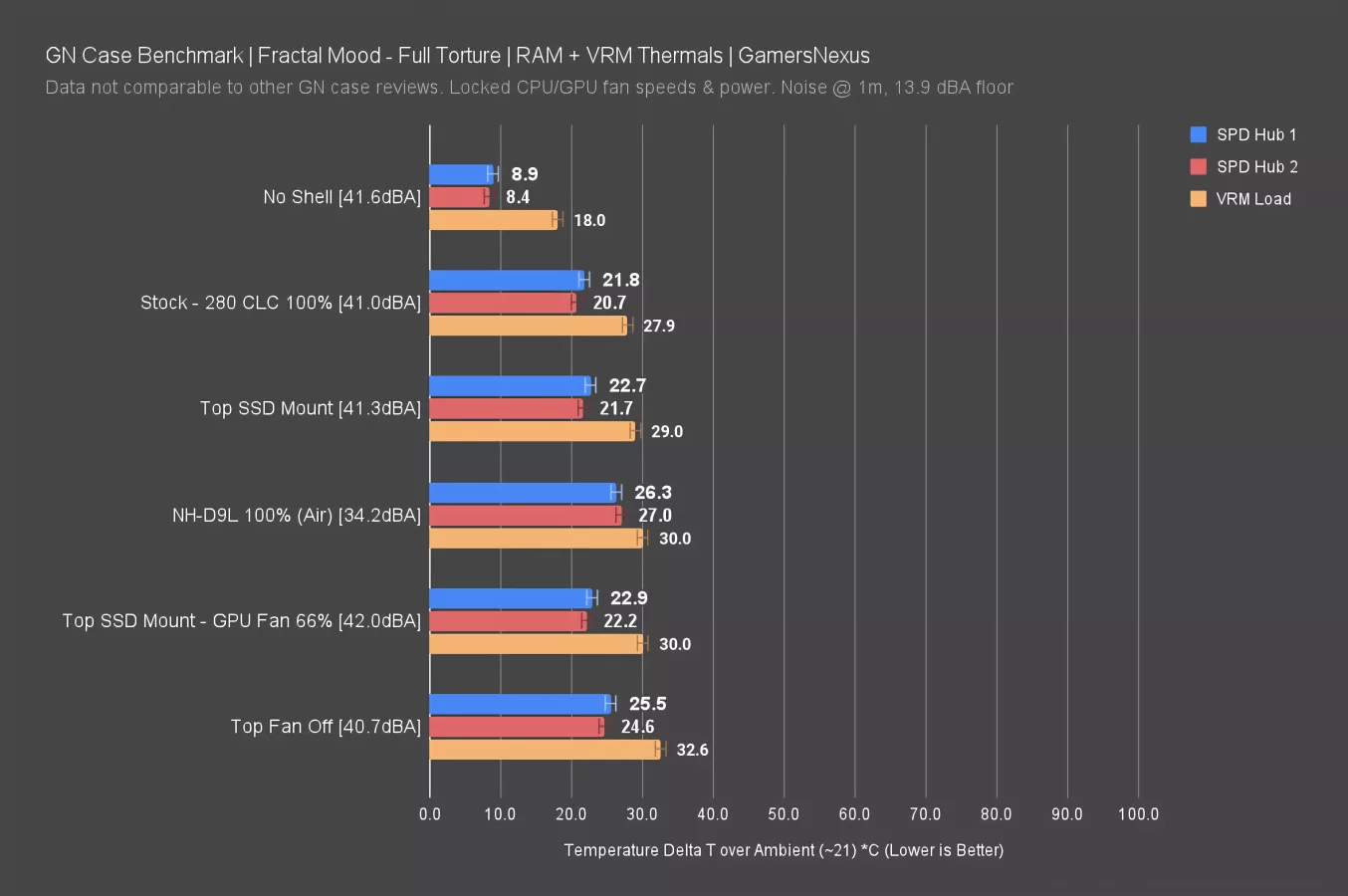
Moving to VRM and RAM thermals again shows us how restrictive the Mood’s shell is, with the no shell result coming in much lower than anything else. The bottom end of the CPU side of the case just doesn’t have anywhere for air to go, which can affect VRM temperatures and RAM.
Other than that, the liquid cooler has an advantage over the air cooler due to the former having a fan blowing directly onto the motherboard.
Noise Testing - 180Hz Hum
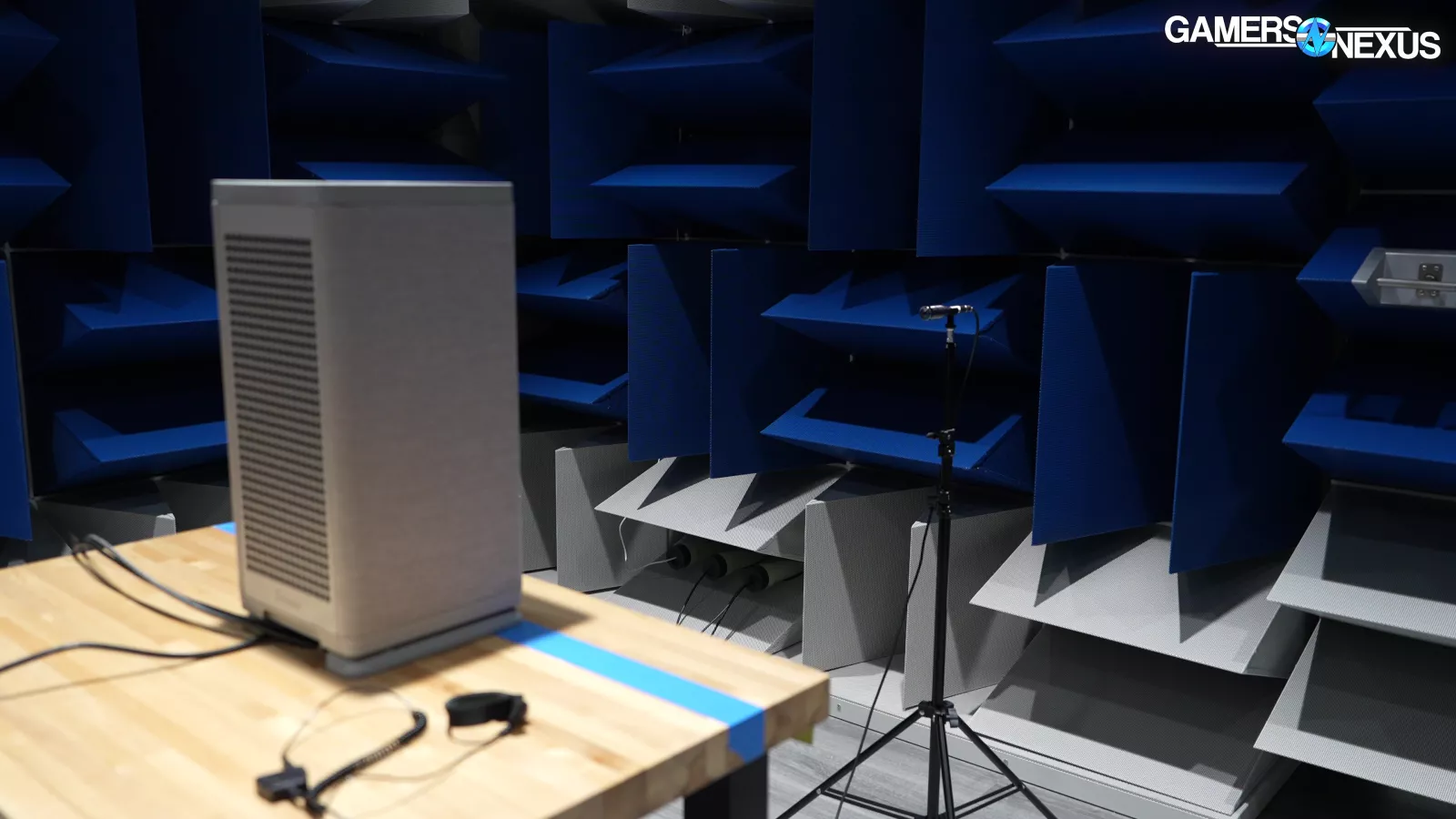
Now onto the acoustic testing in our chamber.
We found something really interesting while going through the data after noise testing. Things like this are made possible by our hemi-anechoic chamber, and building it was only possible via the huge support that we’ve gotten. To continue supporting our efforts to expand accurate testing that uncovers phenomena difficult to explain without specialized equipment, head over to store.gamersnexus.net and grab one of our PC building anti-static Modmats with PC wiring diagrams, screw tracking grids, and reference materials. You can also grab one of our 3D metal emblem pint glasses there to show support.
Here’s the result.
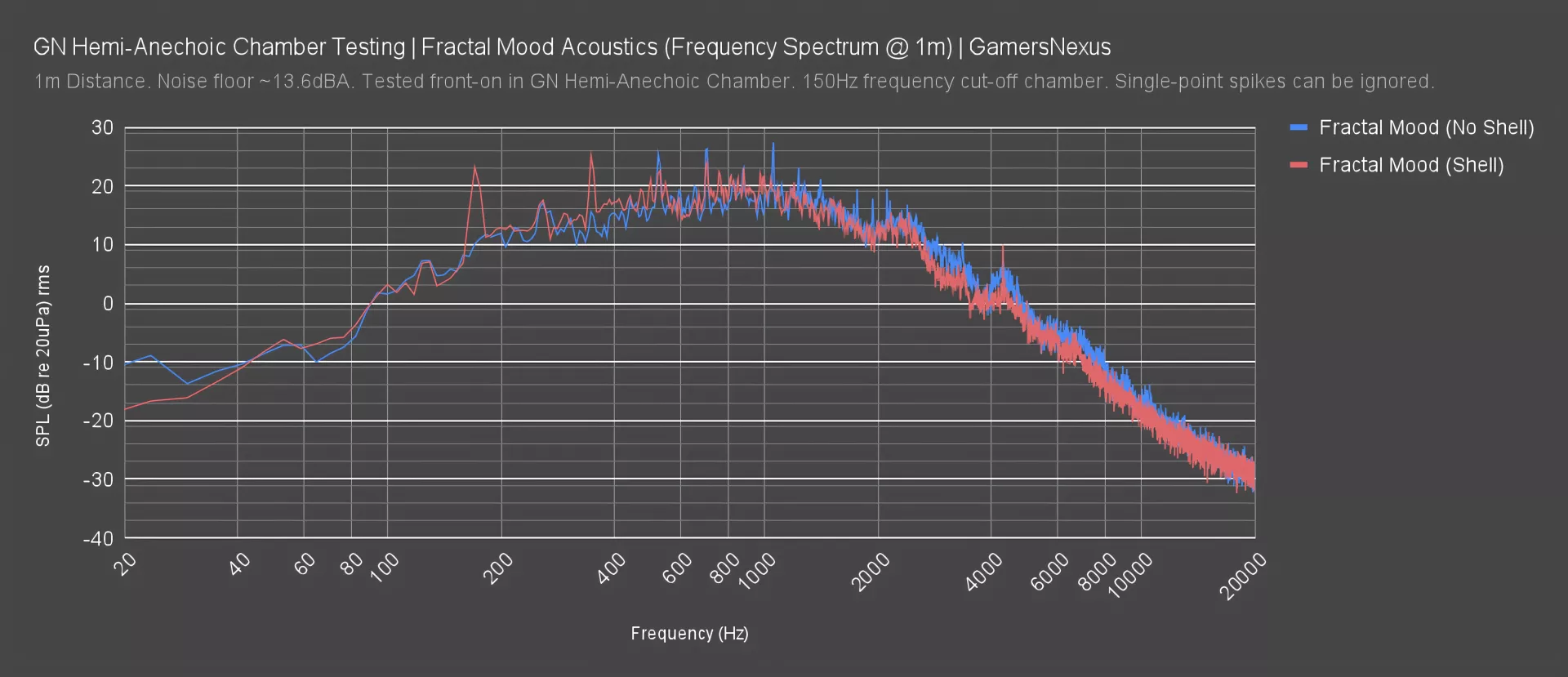
With the 280mm liquid cooler installed, the outer shell of the Mood seems to have a resonant type noise around the 180Hz area, with peaks also forming at the multiples of ~360Hz and ~720Hz. This is clearly audible in the recording, even without isolation. It’s the slow rising and falling drone that sounds something like a distant lawn mower. When the shell is removed, the lower frequency droning sound is gone. You can see that in our frequency spectrum plot, where the shell-less test, despite losing the blocking wall, is quieter in some of the lower and mid frequencies. The wall helps block some of the higher frequencies, as expected.
The noise also wasn’t present during our testing with the NH-D9L air cooler, so some aspect of the CLC fans makes the behavior arise and it’s probably the fact that they are right up against the shell. This could be a blade passing frequency impact.
Here’s an audio sample.
“Distant lawnmower” really is our best description for it.
If you want to learn more about odd acoustic behaviors like this, check out our video with Jakob Dellinger of Noctua.
Fractal Mood Conclusion

The Fractal Mood is a looks-focused case that prioritizes form over function, specifically in regards to thermal performance and airflow.
It is easy to build in but requires extra care when it comes to cable management.
One of its design flaws is that its fabric is restrictive to airflow. We proved this by cutting out one side of the chassis’ fabric and saw a 4 degrees C drop in CPU temperature. A more traditional metal mesh version would be better. The case would also benefit from ventilated sides to allow air to get out near the bottom.
Another design flaw is that the top SSD bracket ends up being restrictive to GPU thermals due to blocking off the PSU exhaust when the PSU is oriented to help with flow-through GPUs. As is, the Mood is better overall as an air-cooled case than with a liquid cooler.
Looking at a competing solution, we think the Cooler Master NCORE 100 MAX pulls off the ITX tower concept better, despite locking you into a bundle of parts.
